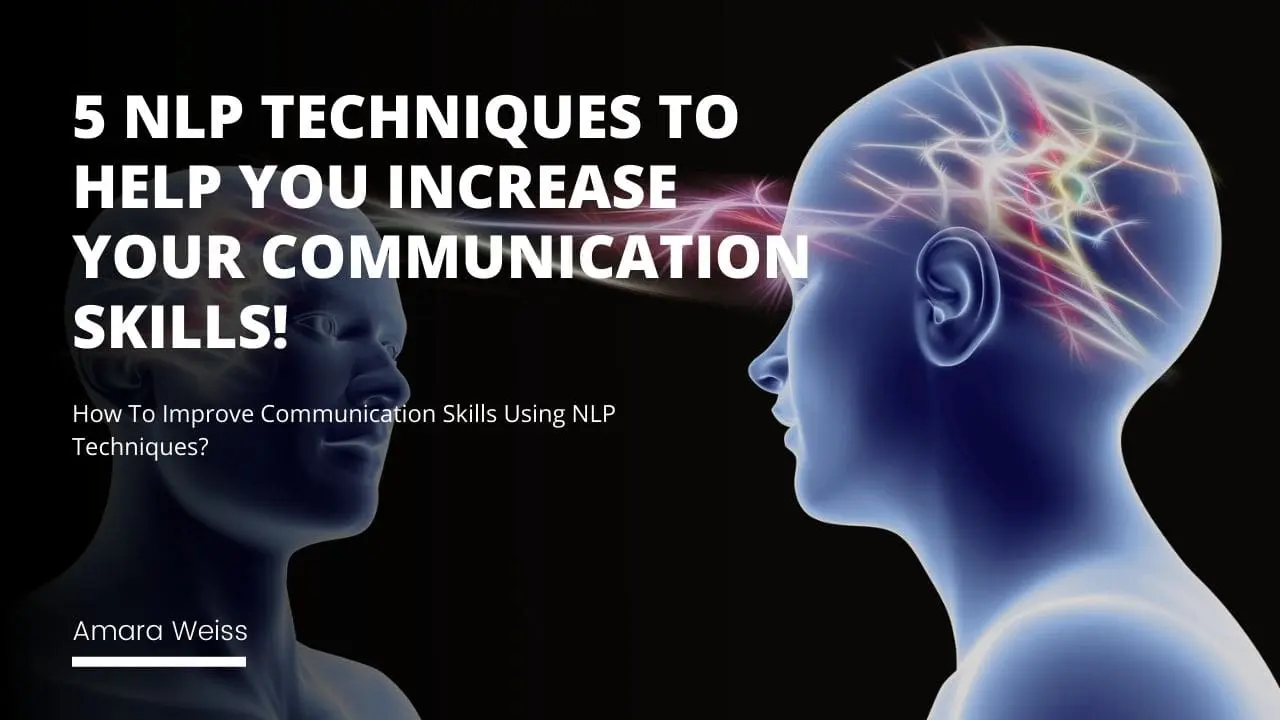
Communication is a fundamental life skill and is essential for success. Communication is exchanging information, ideas, or thoughts through verbal and nonverbal means. It is a crucial factor in maintaining relationships and achieving desired outcomes.
In this article, we will define communication skills, examine why they are so important, identify different types of communication skills, explore how to develop them, and discuss some strategies for improving them.
Don't just talk - listen! Developing your communication skills is key to mastering successful dialogue!

Is communication a skill?
First, let us answer the question, "Is communication a skill?" The short answer is yes; communication is a skill that can be learned and developed with practice. To understand what constitutes effective communication, it is helpful to break down the components involved: verbal (spoken) communication, nonverbal (unspoken) communication, and written communication.
Verbal communication is the exchange of information through words, either spoken or written. It is one of the most important aspects of everyday life, as it is a primary way people interact with each other.
For example, verbal communication is essential in the workplace to ensure clarity and accuracy in instructions and messages delivered between colleagues, management, clients, and customers.
The benefits of effective verbal communication are numerous: improved relationships, greater efficiency in day-to-day operations, enhanced understanding among team members, improved decision-making processes, etc.
However, there can be challenges associated with verbally communicating, such as misunderstanding or difficulty expressing oneself effectively.
Nonverbal communication is an essential part of any conversation and is often more powerful than words alone. Nonverbal communication is a form of communication without words, such as body language, facial expressions, and gestures. It is an essential tool to convey feelings and emotions that may not be transmitted through verbal communication.

The benefits of effective nonverbal communication include increased trust between colleagues, improved morale in the workplace, a better understanding of the speaker's message, and greater communication clarity. However, it is essential to remember that nonverbal cues can be misunderstood or misinterpreted, so it is necessary to pay attention to subtle nuances during interpersonal conversations.
Written communication is another form of communication often used in the workplace. Written communication is typically less personal than verbal or nonverbal forms but can convey information effectively. Written communication is often used to deliver formal instructions, memos, emails, letters, and other documents or reports.
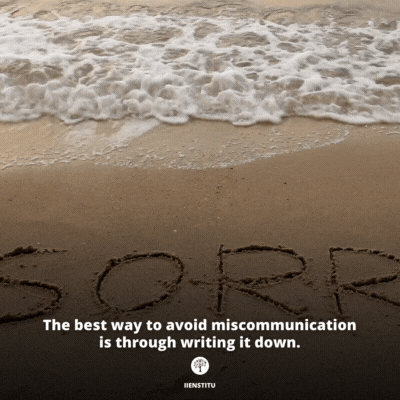
The benefits of effective written communication are manifold: improved accuracy in conveying complex information, greater efficiency in the delivery of necessary information, enhanced collaboration among team members, etc.
However, there is the potential for miscommunication if the language is evident or the message needs to be communicated correctly.
To develop practical communication skills, it is essential to practice active listening. Active listening is a process that involves paying close attention to what is being said by the speaker and responding accordingly. This helps ensure understanding and conveys respect and interest in what is being discussed.
Active listening can also help develop empathy and create stronger interpersonal relationships between colleagues and peers. Additionally, there are strategies for improving active listening, such as focusing undivided attention on the speaker, avoiding interruptions or assumptions about what is being said, and summarizing key points during conversations.
In summary, communication is essential for almost all aspects of life, especially in the workplace. Therefore, it is necessary to understand the different types of communication skills and how to develop and improve them with practice. Furthermore, by mastering these communication skills, employers can ensure efficient operations within their organization, and employees can foster improved relationships with colleagues, clients, and customers.
Defining Communication Skills
Effective communication is a critical component of any successful organization. It is the exchange of thoughts, opinions, and information between two or more people, verbally or non-verbally. Communication is a skill that can be learned and honed through practice.
While verbal communication is the most common form, many other types of communication should also be considered, such as nonverbal and written communication. Understanding different forms of communication are essential to effectively conveying accurate messages and instructions in the workplace.
Why is Communication Important?
Good communication is essential for any business or organization to thrive, so it is crucial to understand why it is so necessary for organizations to foster a practical working environment. Effective communication is necessary for any organization to operate smoothly, from creating trust and understanding amongst colleagues to better conveying complex ideas.
Additionally, organizations must foster strong relationships with customers or clients to maintain loyalty and ensure customer satisfaction.
Understanding why communication is so important is the first step in improving existing skills and developing new ones.
Communication is the key to success, so it's important to understand why it matters.
Types of Communication Skills
There is a common misconception that only intelligent people can be creative. However, research shows that this is not the case and that anyone can be creative if willing to put in the effort. Furthermore, many different types of communication skills can be learned and improved upon with practice.
Verbal communication is the most common form, but many other types, such as nonverbal and written communication, should also be considered. Good communication is essential for any business or organization to thrive, so it is crucial to understand why it is so important for organizations to foster an effective working environment.
Verbal Communication
Verbal communication is the most common form of communication used in the workplace and is essential for delivering key information or instructions accurately and efficiently.
Verbal communication includes conversations, presentations, meetings, and other forms of face-to-face contact that can help build rapport among colleagues or enhance relationships with customers or clients.
Definition
Verbal communication is using spoken language to exchange ideas, feelings, and information between two or more people. It is an essential tool for conveying messages accurately in the workplace as it can provide instant feedback from both parties involved in the conversation.
Benefits and Challenges of Verbal Communication
The advantages of verbal communication are that it is relatively quick and easy to convey a message, can promote better understanding among colleagues or customers, is beneficial when dealing with complex or sensitive topics, and provides immediate feedback, which helps to ensure accuracy in the transmission of information.
On the other hand, there are also some challenges associated with this type of communication, such as difficulty conveying a message clearly due to language or accent barriers, intercultural communication issues, and difficulty understanding what is being said due to excessive noise or lack thereof of clarity.
Nonverbal Communication
Nonverbal communication is an essential form of communication used in the workplace that is often overlooked but is just as important as verbal communication when conveying messages accurately and efficiently
This type of communication includes body language, such as facial expressions, gestures, eye contact, and posture, often used to express emotions or feelings without using words.
Definition
Nonverbal communication uses body language and physical cues such as facial expressions, gestures, and tone of voice to convey a message without using words. It is an essential form of communication in the workplace as it can convey emotions and feelings that may not be expressed verbally.
Benefits and Challenges of Nonverbal Communication
The advantages of nonverbal communication are that it is often better at conveying subtle emotions or feelings, is more direct than verbal communication, and is especially useful when trying to build rapport with colleagues or customers.
On the other hand, there can also be some challenges associated with this type of communication, such as difficulty interpreting body language due to cultural differences or misinterpretation of gestures which could lead to miscommunication.
Written Communication
Written communication is another important form of communication used in the workplace that is often overlooked but equally as important as verbal and nonverbal communication.
This type of communication is primarily used for delivering more complex or detailed messages that require accuracy and is often required when dealing with sensitive topics.
Definition
Written communication uses words to convey a message or information between two or more people. It is an essential form of communication used in the workplace as it can provide a clear and concise method for delivering information accurately and efficiently.
Benefits and Challenges of Written Communication
The advantages of written communication are that it can provide clear instructions, is less prone to misinterpretation due to cultural differences, is beneficial in providing feedback or responding to difficult conversations, is easily recorded, and can be shared among multiple people quickly and efficiently.
However, there can also be some challenges associated with this type of communication, such as difficulty conveying subtle emotions or feelings, which is time-consuming and is often more expensive than other forms of communication.
It is important to note that while all three types of communication (verbal, nonverbal, and written) are essential in the workplace, it is important to understand their advantages and disadvantages when trying to convey a message accurately.
Developing effective communication skills is necessary for success in any professional setting. Therefore, it is important to learn how to use each form of communication appropriately to deliver messages or information accurately and efficiently effectively.
Developing Communication Skills
It's a given that communication is essential in the workplace, but what many people don't realize is that communication is a skill. Just like any other skill, communication can be developed and improved with practice. In this, we will explore the different types of communication skills, the benefits and challenges of each, and how to develop these skills for success in any professional setting.
Active Listening
Active listening is an essential skill used in the workplace that is often overlooked but is just as important as verbal communication when conveying messages accurately and efficiently. Active listening is a process that requires one to listen and focus on the speaker to understand the message being conveyed fully.

Definition and Processes for Active Listening
Active listening is a process that involves paying attention to both verbal and nonverbal cues from the speaker, clarifying any misunderstandings or confusion, asking questions to gain more information about the topic being discussed, repeating back key points of discussion to ensure understanding of the topic, showing support by engaging with the speaker through gestures such as nodding or making eye contact, and providing feedback or advice where appropriate.
Benefits and Strategies for Improving Active Listening
Active listening can improve understanding of the topic being discussed, is beneficial in establishing rapport with colleagues or customers, provides feedback quickly and accurately, is less prone to misinterpretation due to cultural differences, and fosters relationships between individuals or teams.
To become an effective listener, it is important to practice active listening skills regularly, such as avoiding interrupting the speaker, focusing on understanding rather than responding, and giving the speaker your full attention.
Overall, communication is a skill that is essential in any professional setting. Therefore, it is important to understand the different types of communication (verbal, nonverbal, and written) and how they can be used effectively, accurately, and efficiently to convey messages. Furthermore, it is important to develop active listening skills as this is an essential component of communication that is often overlooked but is just as important when conveying messages effectively.
No one is born knowing how to effectively communicate - we all have to learn and practice it.
Therefore, understanding the different types of communication and developing effective communication skills is necessary for success in any professional setting. Doing so will help you communicate more clearly with colleagues and customers, foster relationships, achieve goals quickly and efficiently, and gain respect from your peers.
Taking the time to understand the importance of communication skills within a professional environment and applying them appropriately can lead to personal and professional success. In addition, investing in yourself to become a better communicator is a skill that is invaluable and will benefit you in the long term.
Moreover, creating lasting relationships is often a result of effective communication and is highly valuable in any professional setting. With strong communication skills, it is possible to build trusting and successful relationships with colleagues or customers that are mutually beneficial.
These are just some reasons why it is important to understand and develop communication skills within a professional setting. Taking the necessary steps to do so can help lead to great personal and professional success. Investing in yourself to become a better communicator is an invaluable skill that will serve you throughout your career. By taking the time to understand how different types of communication can be used effectively and developing active listening skills, it is possible to create lasting relationships and become a successful communicator.

Frequently Asked Questions
What is the purpose of communication?
The purpose of communication is to share information and ideas between two or more people. Communicating effectively makes it possible to achieve various goals, such as establishing relationships, conveying messages accurately, resolving conflicts, and gaining respect from colleagues.
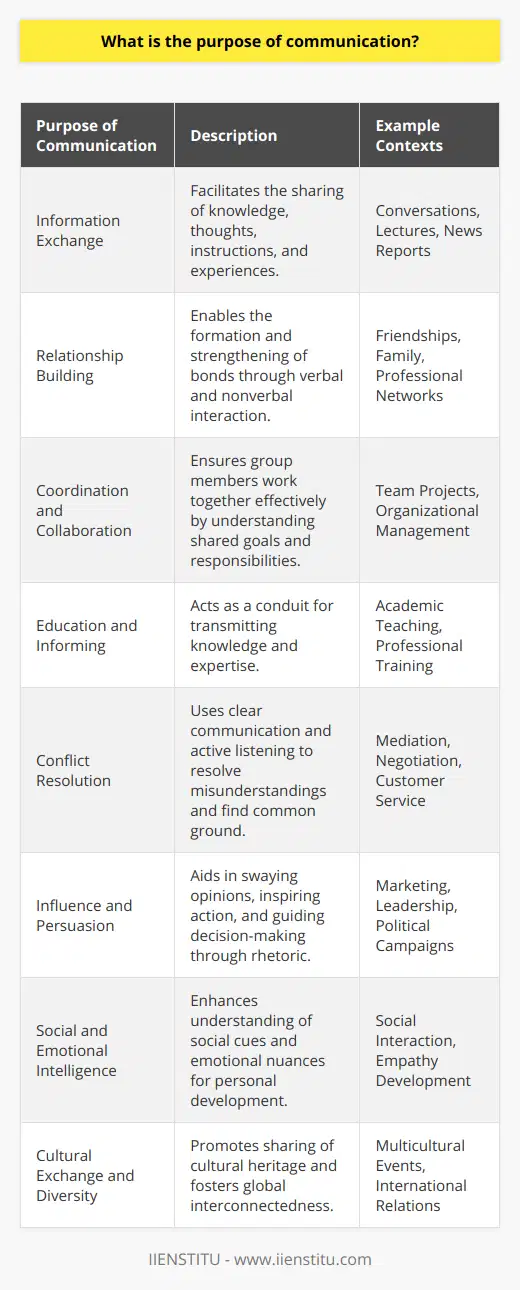
What are the different types of communication?
Many types of communication (verbal, nonverbal, written) can be used depending on the situation. Therefore, it is important to understand the different types to communicate effectively.
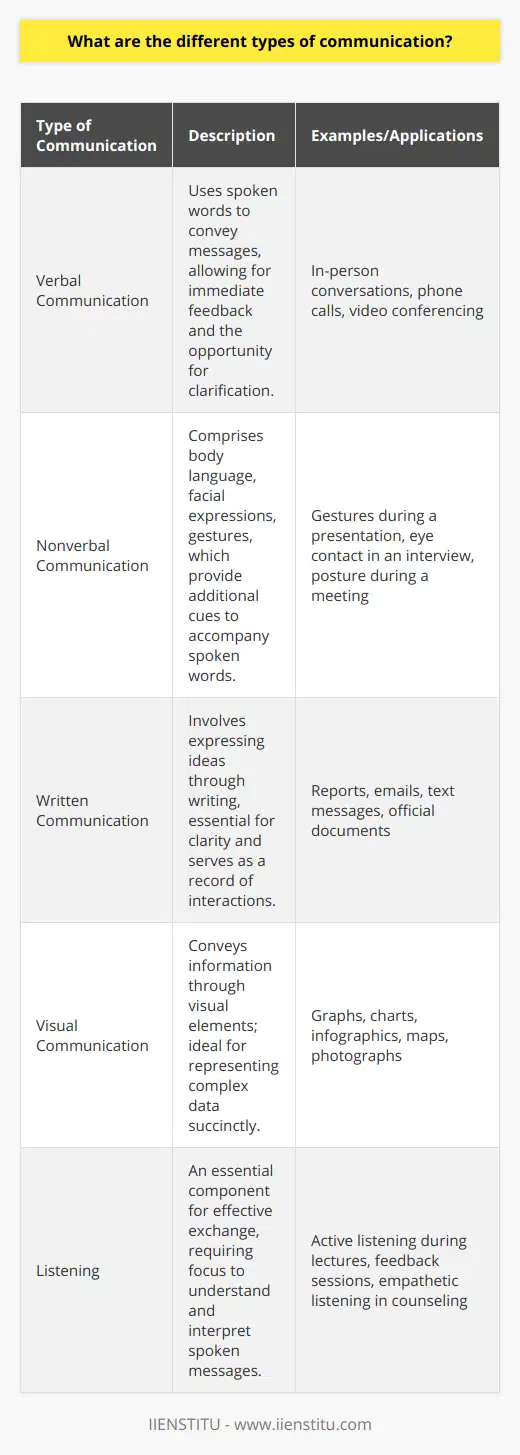
What is active listening?
Active listening is a process where the listener pays attention and tries to understand the message being conveyed by the speaker. It is often an overlooked communication component but is just as important when understanding a message accurately.
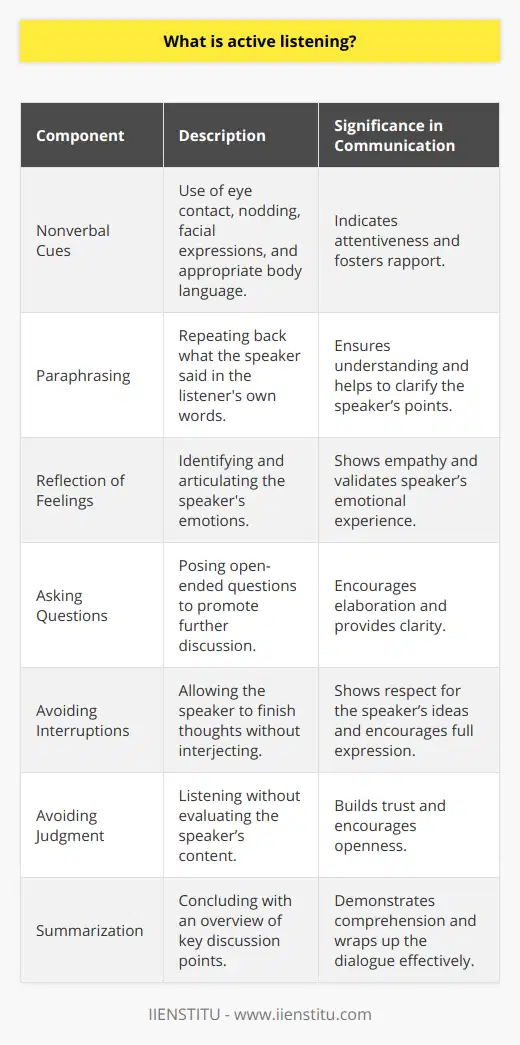
How can I become more confident in my communication skills?
Practice speaking in front of a mirror or with friends.
Participate in public speaking events or join a local Toastmasters club.
Read books and articles about communication skills and practice the techniques you learn.
Actively listen to the conversations of those around you, and take the time to observe and analyze how they communicate.
Take a class or workshop on communication or related topics.
Make a conscious effort to be more assertive, especially when it comes to expressing your thoughts and opinions.
Seek feedback from those you communicate with and use it to improve your communication skills.
Make sure you understand the context and purpose of each conversation and adjust your communication style accordingly.
Learn how to properly handle difficult conversations and build strong relationships with those you communicate with.
Set specific goals for yourself and track your progress over time.
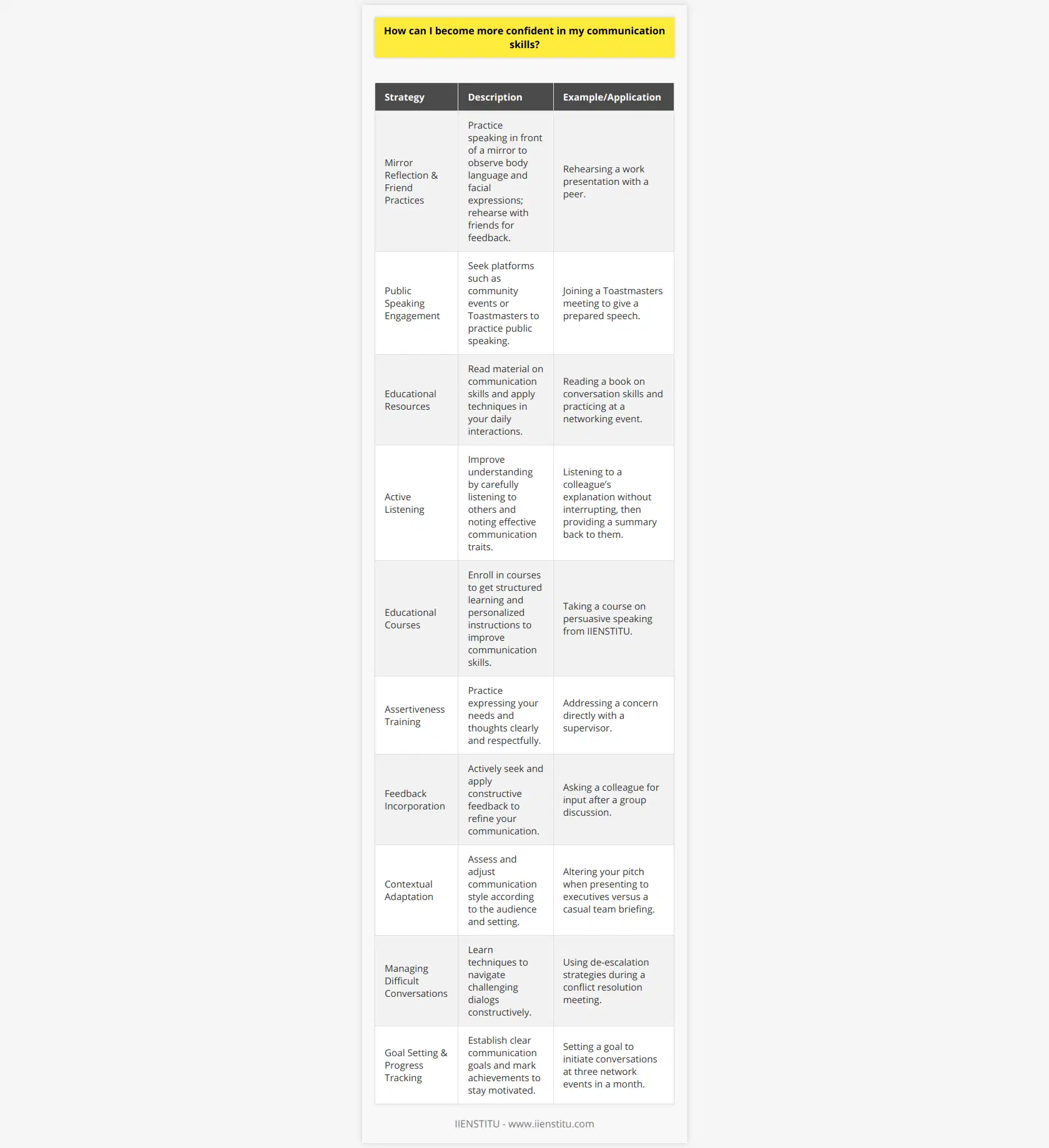
What techniques can I use to better understand the communication style of others?
Observe how they communicate with others.
Ask open-ended questions.
Listen attentively.
Ask for clarification if something is not clear.
Pay attention to body language and facial expressions.
Maintain an open and non-judgmental attitude.
Be aware of cultural differences.
Avoid making assumptions.
Take time to reflect on interactions.
Practice active listening.

How can I ensure that my communication is clear and effective?
Use simple, concise language and avoid jargon.
Listen carefully to ensure that your message is understood.
Ask questions to ensure that you understand the other person’s viewpoint.
Consider the other person’s feelings and use an appropriate tone.
Give examples to help illustrate your point.
Pay attention to body language, facial expressions, and other nonverbal cues.
Use technology appropriately to ensure your message is delivered clearly.
Reiterate key points when appropriate.
Make sure to follow up to ensure your message was received properly.
Be open to feedback and willing to adjust your message if needed.
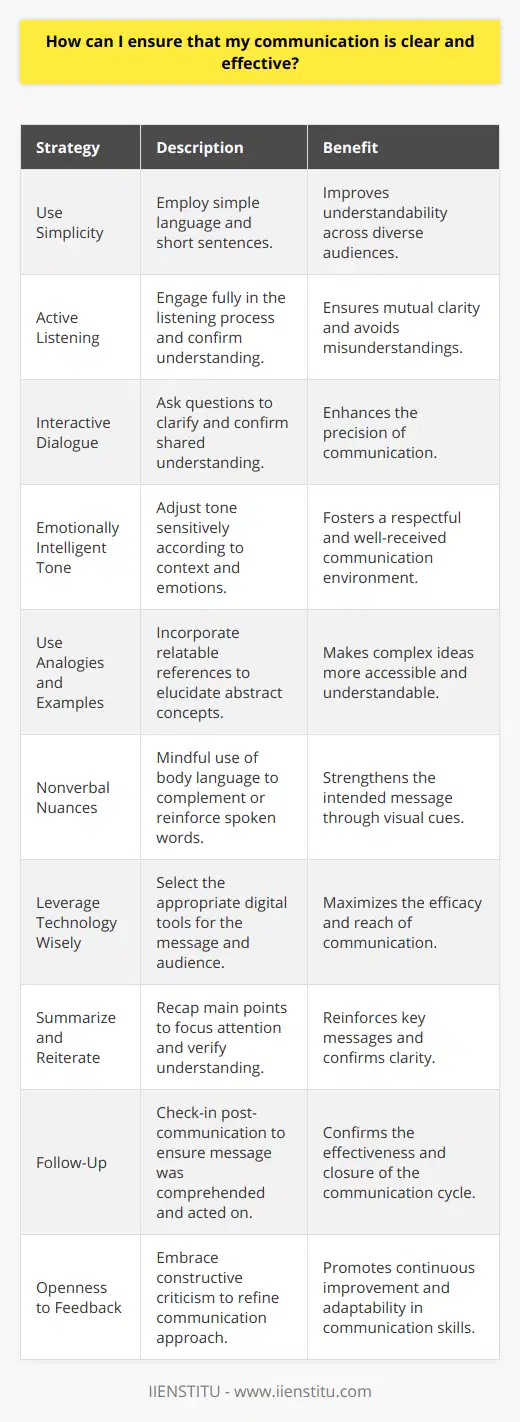
Is it communication skills or skill?
Importance of Clear Terminology
In discussing the effectiveness of communication, it is crucial to clarify whether we are referring to 'communication skills' or a singular 'communication skill.' Understanding the difference between the two terms helps us examine the role of language in achieving successful communication.
Communication Skills: A Pluralistic Approach
Communication skills refer to a broad set of abilities that enable individuals to effectively exchange information, ideas, and emotions with others. These include listening, speaking, writing, reading, body language, and even empathy. By mastering these various skills, individuals improve their chances of achieving effective communication in diverse contexts. For example, a skilled communicator can adjust their speaking style to suit the audience, identify emotional cues in social settings, and write clear and concise documents.
The Complex Nature of a Single Skill
On the other hand, a singular communication skill would imply that there is only one essential ability required to ensure successful communication. However, this notion ignores the complexity of human interaction and the numerous factors that can influence communication, such as cultural differences, language barriers, and personal preferences. Therefore, focusing solely on one skill is unlikely to guarantee effective communication across different scenarios and diverse groups of people.
The Role of Multiple Skills in Effective Communication
To communicate effectively, it is essential to consider both the primary skills, such as speaking and listening, and the secondary skills, such as cultural awareness and emotional intelligence. By developing and refining these multiple skills, individuals can better navigate the complexities of human interaction.
In conclusion, the term 'communication skills' is more accurate and comprehensive, as it acknowledges the multifaceted nature of human communication. Effective communication requires a combination of various abilities, and focusing solely on a singular skill would overlook the intricacies of interpersonal exchanges. Developing a well-rounded set of communication skills is essential to engage successfully in diverse contexts and interact with different individuals.
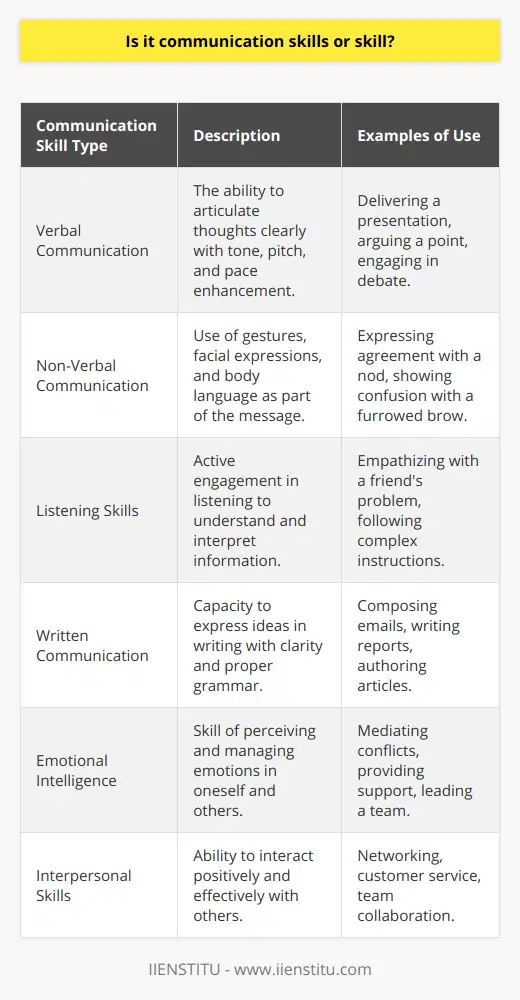
What are the 5 main communication skills?
Effective Communication Skills: A Brief Overview
**Listening Skills**
The foundation of effective communication lies in active listening. It involves being fully present and attentive to the speaker, comprehending the information, and processing it to provide relevant feedback. Good listening enables mutual understanding and fosters strong interpersonal connections.
**Verbal Communication Skills**
Verbal communication skills involve the careful selection of words, tone, and pace in relaying messages. It is crucial to choose words that precisely convey the intended meaning and to organize ideas in a clear and structured manner. Practicing proper grammar, pronunciation, and articulation also helps to reinforce the message.
**Nonverbal Communication Skills**
Gesture, facial expression, posture, and eye contact fall under nonverbal communication skills. These elements can support or undermine a message, as they often give clues to a speaker's emotions, credibility, or sincerity. The ability to read and interpret nonverbal cues aids in avoiding misunderstandings and promotes better interpersonal relations.
**Writing Skills**
Well-developed writing skills allow an individual to create clear, concise, and professional written communication. Effective writing entails proper grammar, punctuation, and vocabulary, as well as the ability to structure ideas cohesively. Strong writing skills are necessary for success in academic, personal, and professional settings alike.
**Interpersonal Skills**
The final essential skill set for communication is interpersonal skills, which include empathy, patience, humor, and politeness. Establishing rapport and forging meaningful connections rely on displaying these qualities in both verbal and nonverbal interactions. Effective interpersonal skills create an environment of trust, fostering open dialogue and collaboration.
In conclusion, communication skills encompass a range of abilities, from active listening to clear and effective writing. Developing these five central skills – listening, verbal and nonverbal communication, writing, and interpersonal abilities – can facilitate greater understanding between individuals and foster strong relationships, leading to personal and professional success.
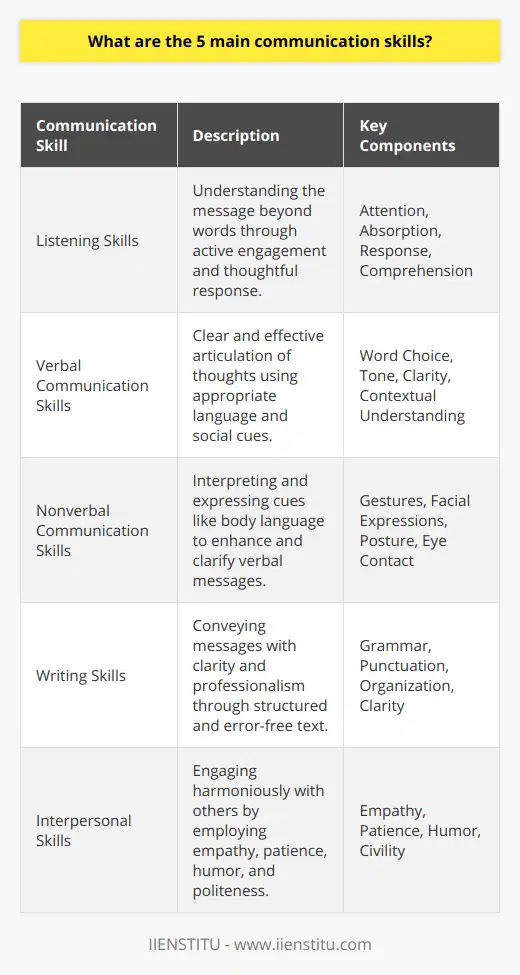
What type of skill is communication?
Defining Communication Skills
The skill of communication is a multifaceted phenomenon that encompasses various abilities and competencies. In general, communication skills can be classified into three primary categories, namely, verbal, non-verbal, and written communication.
Verbal Communication Skills
Verbal communication, the most commonly recognized form, relies on spoken language to convey information, ideas, and feelings. Effective verbal communicators can articulate thoughts clearly, maintain confident and engaging tones, and adjust their speech to suit the audience or context. Active listening, empathizing, and providing constructive feedback are also indispensable components of strong verbal communication.
Non-Verbal Communication Skills
Non-verbal communication involves the use of non-linguistic cues such as body language, facial expressions, and gestures to express emotions, offer feedback, or establish connections. Highly skilled non-verbal communicators can accurately interpret these signals, control their expressions to convey intended emotions, and demonstrate openness, attentiveness, and rapport during interactions. Non-verbal sensitivities further enhance the efficacy and nuance of one's overall communicative competence.
Written Communication Skills
Lastly, written communication encompasses the creation and interpretation of text-based messages. This covers various formats, such as emails, reports, essays, and social media updates. Strong written communication skills involve the ability to produce clear, concise, and well-structured content tailored to the intended audience. This necessitates proficient grammar, syntax, and vocabulary knowledge, as well as the capacity to adapt one's writing style according to purpose and context.
In conclusion, communication is a multifarious skill that relies on numerous abilities spanning verbal, non-verbal, and written forms. Developing these diverse competencies enhances interpersonal relationships, fosters collaboration, and contributes to personal and professional growth. It is crucial to acknowledge and address each aspect of these three primary communication categories to cultivate and refine one's communicative prowess.
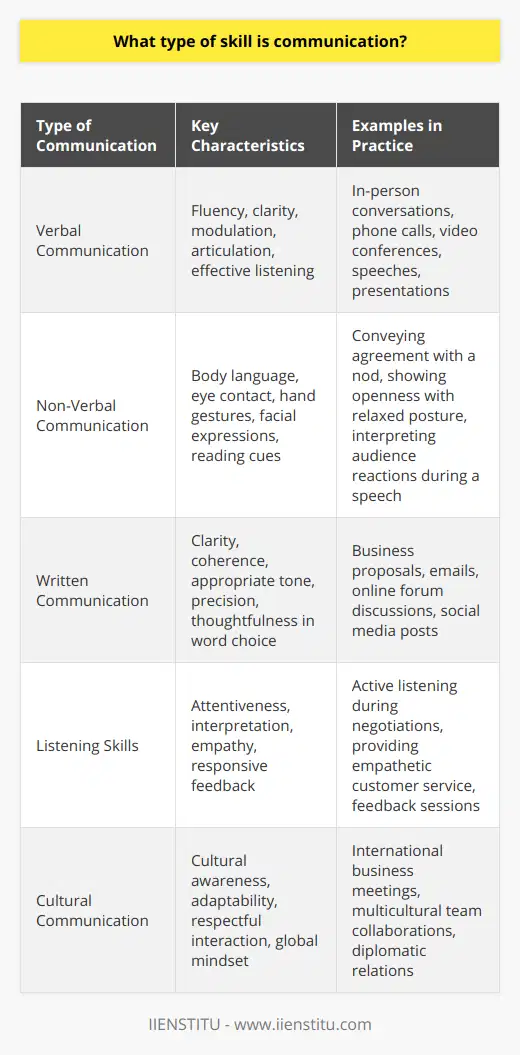
What are the 3 types of communication skills?
Types of Communication Skills
Verbal Communication
The first type of communication skill is verbal communication, which involves the use of spoken or written words to convey a message or share information. This is essential in various contexts, from casual conversations to professional presentations, negotiating deals, or writing e-mails.
Nonverbal Communication
The second type is nonverbal communication, which refers to the use of body language, facial expressions, tone of voice, and gestures to communicate or emphasize messages. It is critical, as it serves to reinforce or contradict verbal messages, showing emotions or attitudes that may not be readily apparent through words. Nonverbal communication is vital, considering that research has shown that more than 60% of communication is nonverbal.
Listening Skills
Finally, the third type of communication skill is listening - the capability to attentively receive and comprehend spoken or nonverbal messages, while avoiding the barriers that can hinder understanding. Active listening involves acknowledging the thoughts and feelings of the speaker, clarifying unclear points, and giving feedback to ensure that the message is understood correctly. This skill plays a significant role in fostering effective communication and building strong interpersonal relationships.
In conclusion, the three types of communication skills - verbal communication, nonverbal communication, and listening skills - are all essential for effective communication in various contexts, and developing these abilities is crucial for both personal and professional success.
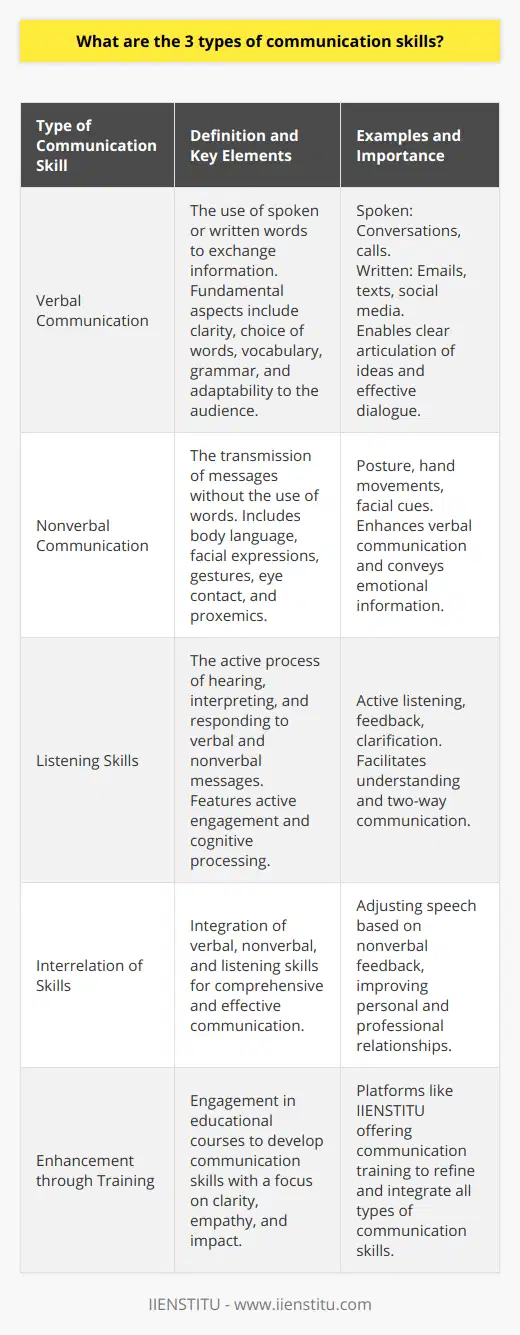
What are the 7 skills of communication?
Effective Communication Skills: An Overview
To excel in personal and professional life, effective communication skills are essential. There are seven key communication skills that can enhance an individual's ability to convey their message efficiently and create a constructive dialogue with others.
Listening Skills
Active listening is crucial for understanding the speaker's viewpoints and emotions effectively. Paying attention to both verbal and nonverbal cues, asking clarifying questions, and providing feedback builds trust and strengthens interpersonal connections.
Verbal Communication
Articulating ideas and thoughts clearly contributes to better comprehension among the communicating parties. Speaking with confidence, using appropriate language, maintaining eye contact, and avoiding jargon ensures that the intended message is communicated effectively.
Nonverbal Communication
Body language, facial expressions, and gestures communicate emotions and attitudes that supplement verbal communication. Being mindful of posture, hand movements, facial cues, and tone of voice can enhance the effectiveness of the message being conveyed.
Written Communication
Writing clearly and concisely is vital for effective communication in personal and professional settings. Good grammar, punctuation, and sentence structure, coupled with a coherent flow of ideas, allows readers to grasp the message quickly.
Emotional Intelligence
Recognizing and managing one's emotions, as well as understanding others' emotions, is key to successful communication. Empathy, self-awareness, and self-regulation promote a supportive and collaborative environment that fosters open and honest dialogue.
Assertiveness
Assertive communication strikes a balance between being passive and aggressive. Clearly expressing needs, opinions, and feelings in a respectful manner allows for productive discussions and minimizes conflicts.
Adaptability
Being versatile in communication styles helps establish rapport with diverse individuals. Adapting communication techniques based on different contexts, cultures, and personalities fosters effective interactions and enhances mutual understanding.
In conclusion, developing and maintaining these seven communication skills are crucial for personal and professional success. By actively listening, articulating thoughts effectively, utilizing nonverbal cues, writing clearly, demonstrating emotional intelligence, communicating assertively, and adapting to diverse situations, individuals can navigate various interpersonal interactions with ease and confidence.
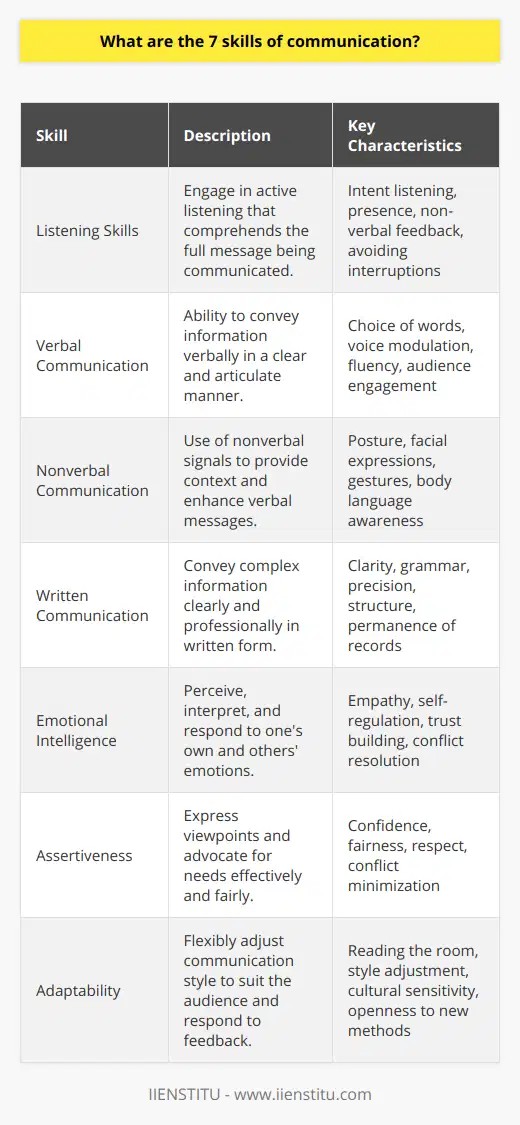
How can we improve nonverbal communication in an academic setting?
Enhancing Nonverbal Communication Skills
A critical aspect in any setting, nonverbal communication can be improved in an academic environment through various methods. Firstly, fostering self-awareness among students and educators is essential to understanding their individual nonverbal cues. Engaging in self-reflection, monitoring facial expressions, and interpreting body language can all contribute to enhanced self-awareness.
Encouraging Positive Feedback
Additionally, peer feedback plays a vital role in improving nonverbal communication skills. Collaborative exercises, such as group discussions and presentations, allow students to observe and provide feedback on each other's nonverbal cues. This approach promotes a supportive learning atmosphere that explores different communication styles and identifies strengths and weaknesses in conveying intentions without using verbalized words.
Broadening Cultural Competence
Moreover, building cultural competence is vital for effective nonverbal communication in an academic setting, particularly as classrooms become more diverse. Developing an understanding of various cultural norms, including gestures and social cues, enables students and educators to reduce the chances of misunderstandings and misinterpretations. Integrating training sessions on cultural sensitivity can foster a more inclusive environment that values diverse perspectives.
Utilizing Technology
Harnessing technology in the form of video recording is another useful strategy for recognizing and analyzing nonverbal cues. By observing their recorded behavior during presentations or discussions, students can better understand personal habits and areas needing improvement. Similarly, this can be a powerful tool for educators to refine their teaching styles, ensuring the success of classroom interactions.
Emphasizing the Importance of Active Listening
Lastly, active listening is crucial in enhancing nonverbal communication, as it demonstrates genuine interest and respect for the speaker. Maintaining eye contact, using open body language, and providing appropriate gestures such as nodding are all components of active listening that can lead to an environment in which effective communication thrives.
In summary, self-awareness, peer feedback, cultural competence, technological resources, and active listening are all key factors that contribute to strengthening nonverbal communication in an academic setting. By consciously employing these strategies, students and educators can create a more positive and inclusive educational environment.
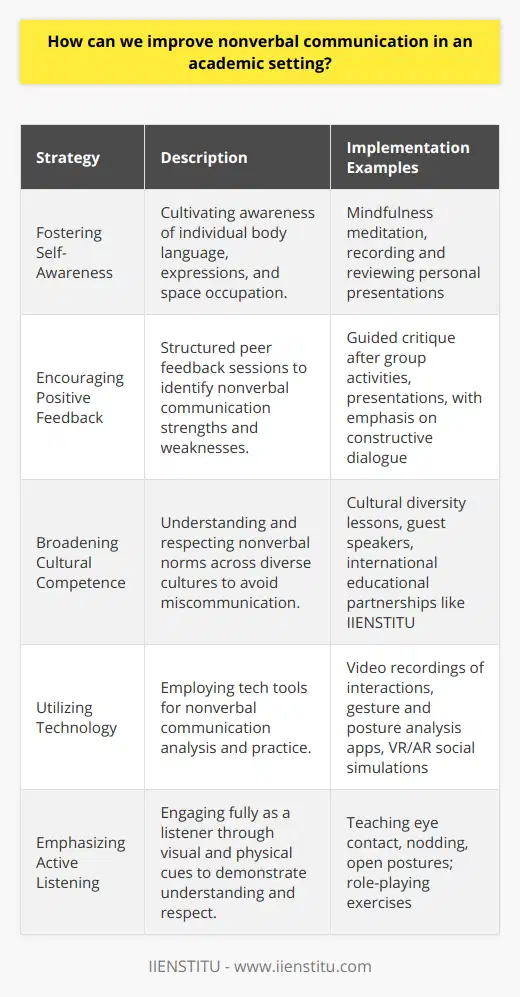
What are the key components of effective communication in an academic setting?
Importance of Clarity and Organization
Effective communication in an academic setting encompasses various key components, with clarity and organization being among the most critical. The ability to articulate ideas and information clearly and coherently allows for better understanding among all participants in the learning process. This may involve simplifying complex concepts, using analogies or examples to illustrate ideas, and avoiding jargon, as these practices can facilitate easier comprehension and engagement with the material.
Active Listening Skills
Another vital component of successful academic communication is active listening skills. By actively engaging with the speaker, learners demonstrate their attentiveness, a willingness to understand, and a commitment to the learning process. This involves not only paying attention to the content being presented but also asking questions, offering feedback, and providing constructive criticism where appropriate. Moreover, practicing effective listening promotes a respectful and collaborative environment, a key factor when fostering healthy discussions and debates.
Nonverbal Communication
Nonverbal communication plays an equally crucial role in facilitating academic interactions. Elements such as facial expressions, body language, and eye contact can convey emotions, attitudes, and levels of engagement, which can significantly impact the dynamics of the learning environment. By being aware of these nonverbal cues, both speakers and listeners can better understand one another and adapt their communication strategies accordingly.
Cultural Sensitivity and Inclusiveness
Effective academic communication also requires embracing cultural sensitivity and inclusiveness. Universities and educational institutions often bring together individuals from diverse cultural and linguistic backgrounds, making it essential for all parties to respect and appreciate these differences. By fostering an inclusive and culturally sensitive environment, educators and learners can better understand each other's perspectives, break down communication barriers, and enhance the quality of the learning experience.
Use of Technology
Lastly, the use of technology within an academic setting is an indispensable aspect of effective communication. Incorporating multimedia elements, digital tools, and online platforms can greatly enhance the ways in which information is presented and shared, thus facilitating more engaging and interactive learning experiences. Furthermore, embracing technology can make the learning process more accessible to those who may face challenges or limitations within traditional educational settings.
In conclusion, the key components of effective communication in an academic setting include clarity and organization, active listening skills, nonverbal communication, cultural sensitivity and inclusiveness, and the use of technology. By prioritizing these aspects, both educators and learners can foster productive and meaningful academic environments.
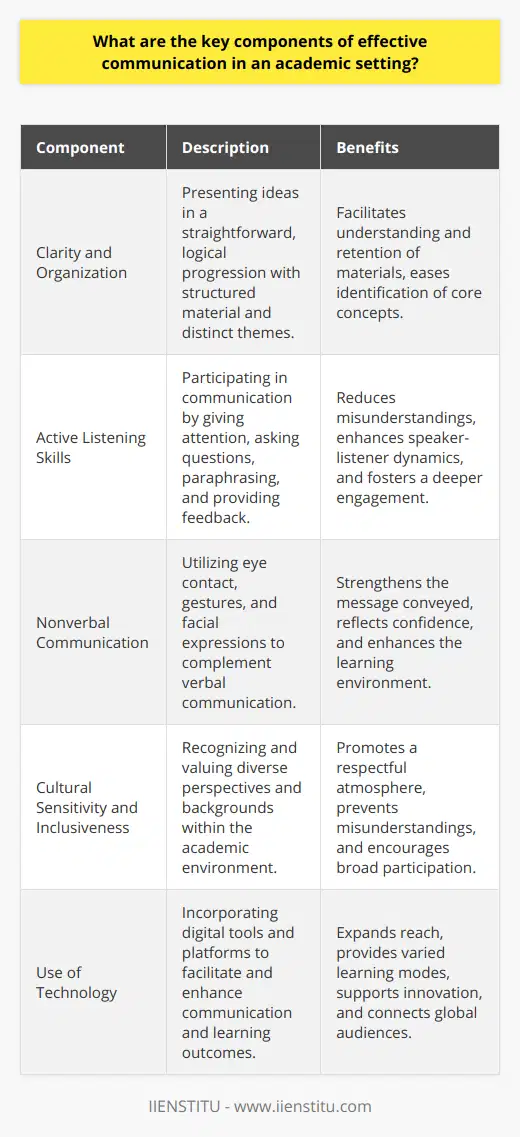
How does cultural background influence communication styles and expectations?
Cultural Background Dimensions
Cultural backgrounds play a crucial role in determining an individual's communication style and expectations. People belonging to different cultures exhibit distinct communication patterns, values and norms, influencing how they understand and interpret messages. The degree of cultural influence on communication can be analyzed through specific dimensions, including context, power distance, individualism vs. collectivism, and verbal and nonverbal cues.
Contextual Differences
High-context cultures mostly rely on implicit information and shared understanding established through context, while low-context cultures prefer explicit messages and direct communication. For example, Japanese culture is high-context, focusing on reading between the lines and interpreting nonverbal cues. Conversely, the American culture is low-context, prioritizing clarity and directness in their conversations. Understanding contextual differences based on cultural background helps bridge the communication gap and avoid misunderstandings.
Power Distance Influence
The power distance dimension in communication entails the degree to which a culture accepts and expects power inequalities. In high-power-distance cultures like India or Mexico, communication styles often involve hierarchical structures, formality, and respect for authorities. In low-power-distance cultures such as Denmark or Sweden, communication is more egalitarian, informal, and focused on consensus-building. Awareness of such hierarchies and social structures helps effectively navigate different cultural communication environments.
Individualism and Collectivism
Individualistic cultures, such as the United States, promote autonomy and self-expression, leading to a direct and assertive communication style. Collectivist cultures, like China, prioritize group harmony and social conformity, resulting in indirect and polite communication to maintain relationships. Recognizing these cultural value orientations enables individuals to adjust their communication approach and meet foreign counterparts' expectations.
Verbal and Nonverbal Cues
Language plays an essential role in shaping communication styles as individuals from different cultures possess unique ways of expressing themselves verbally. For instance, idiomatic expressions, humor, and metaphors might not necessarily translate well across cultures due to their contextual nature. Additionally, nonverbal communication, such as gestures, facial expressions, and body language, varies across cultures, making it crucial to be knowledgeable about these aspects to avoid misinterpretation.
In conclusion, cultural background significantly impacts communication styles and expectations, influencing how individuals from different regions interact and comprehend messages. Increased awareness of cultural differences and adaptability helps overcome communication barriers and fosters positive intercultural exchanges.
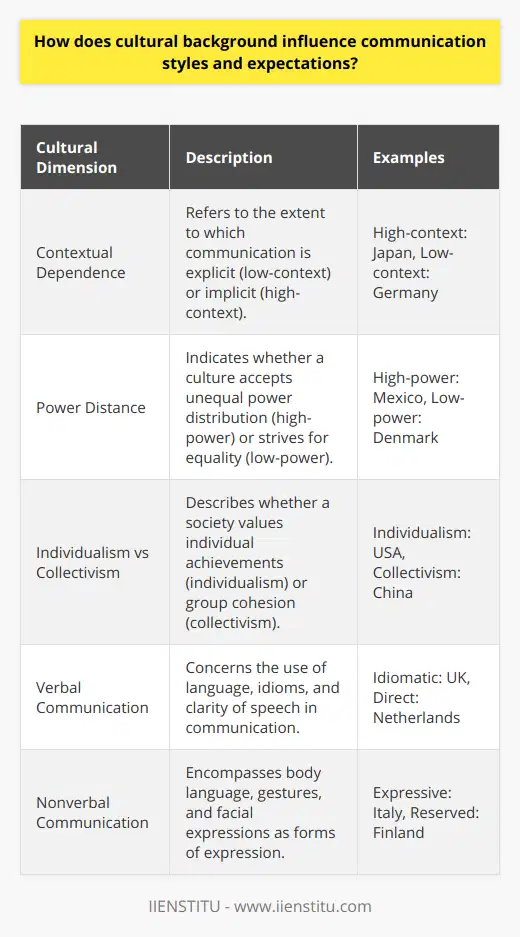
Can emotional intelligence be considered an essential aspect of communication skills?
Emotional Intelligence and Communication Skills
Significance of Emotional Intelligence
Emotional intelligence plays a crucial role in effective communication, as it enables individuals to understand and manage their emotions, empathize with others, and navigate social situations. Emotional intelligence comprises various skills necessary for successful interpersonal relationships, including self-awareness, self-regulation, motivation, empathy, and social skills.
Improved Understanding of Emotions
A strong foundation in emotional intelligence helps individuals to recognize their emotions and their influence on the way they communicate. By being self-aware, individuals can tailor their communication style to fit their message and audience, making for a more accurate and effective transmission of information. Furthermore, they can also accurately interpret the emotional cues of others, thus allowing for a better adaptation of communication strategies.
Enhanced Emotional Regulation
Emotional intelligence also fosters emotional regulation – the ability to manage one's emotions – which is particularly important in instances of conflict or high-pressure situations. By exercising self-control and effectively regulating their emotional reactions, individuals are better equipped to communicate clearly and calmly, ultimately leading to an increased likelihood of positive resolution or understanding of differing viewpoints.
Promotion of Empathy and Active Listening
An emotionally intelligent person is naturally more empathetic, which means they can better understand and relate to the feelings and perspectives of others. This sense of empathy promotes active listening, a vital aspect of effective communication that requires the listener to genuinely engage with, and respond to, the speaker. By doing so, individuals can foster trust, develop rapport, and ultimately, promote stronger interpersonal relationships.
Development of Effective Social Skills
Lastly, mastering emotional intelligence leads to improved social skills, such as the ability to navigate and adapt to different social contexts and engage in appropriate verbal and non-verbal communication. With well-developed social skills, individuals can accurately convey messages, respond to feedback, and collaborate effectively in personal and professional settings.
In conclusion, emotional intelligence is, indeed, an essential aspect of communication skills, as it promotes self-awareness, emotional regulation, empathy, active listening, and effective social skills. By fostering emotional intelligence, individuals can enhance their communication abilities and build stronger interpersonal relationships in diverse contexts.
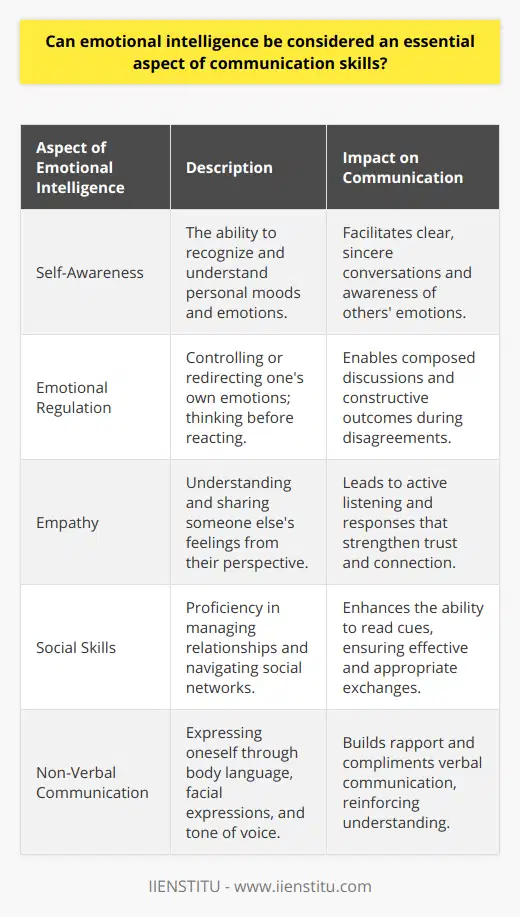
What are the key principles of effective academic communication?
Key Principles of Effective Academic Communication
Clarity and Conciseness
Effective academic communication emphasizes clarity and conciseness. Communicators must ensure that their messages are expressed using simple, precise language that avoids ambiguity or confusion. Further, concise sentences allow readers to comprehend information more efficiently, without unnecessary repetition or lengthy explanations.
Appropriate Formatting and Structure
Another crucial aspect of effective academic communication is the proper use of formatting and structuring techniques. This includes organizing content into coherent paragraphs, using headings and subheadings for improved readability, and employing appropriate citation styles to acknowledge sources correctly.
Accurate and Relevant Information
As academic communicators, it is essential to ensure that the information presented is accurate and relevant to the topic at hand. This includes conducting thorough research from credible sources, recognizing and addressing potential biases, and continuously updating knowledge to stay current with advances in the field.
Logical Argumentation and Critical Thinking
A well-structured argument is crucial for effective academic communication. This involves presenting a clear thesis statement or research question, developing sound reasoning backed by evidence, addressing counterarguments, and drawing logical conclusions based on the presented data. Critical thinking allows communicators to analyze and evaluate information objectively, which in turn strengthens their overall arguments.
Formal and Professional Tone
An essential principle of academic communication is using a formal and professional tone. This includes avoiding colloquial language, contractions, or personal anecdotes that may diminish the credibility of the communication. Further, adopting a neutral stance and avoiding emotive language when presenting arguments ensures that the focus remains on the evidence rather than personal opinions.
Active and Engaging Style
Finally, effective academic communication entails utilizing an active and engaging writing style when presenting information. This includes avoiding passive voice structures and lengthy sentences that may hinder readability. Also, incorporating varied sentence structures, appropriate transitions, and signposting language helps to guide readers through the text, making it more accessible and comprehensible.
In conclusion, the key principles of effective academic communication involve clarity, concise language, appropriate formatting, accurate and relevant information, logical argumentation, critical thinking, a formal and professional tone, and an active and engaging writing style. By adhering to these principles, academic communicators can ensure that their messages are well-received and understood, ultimately contributing to the advancement of knowledge within their respective fields.
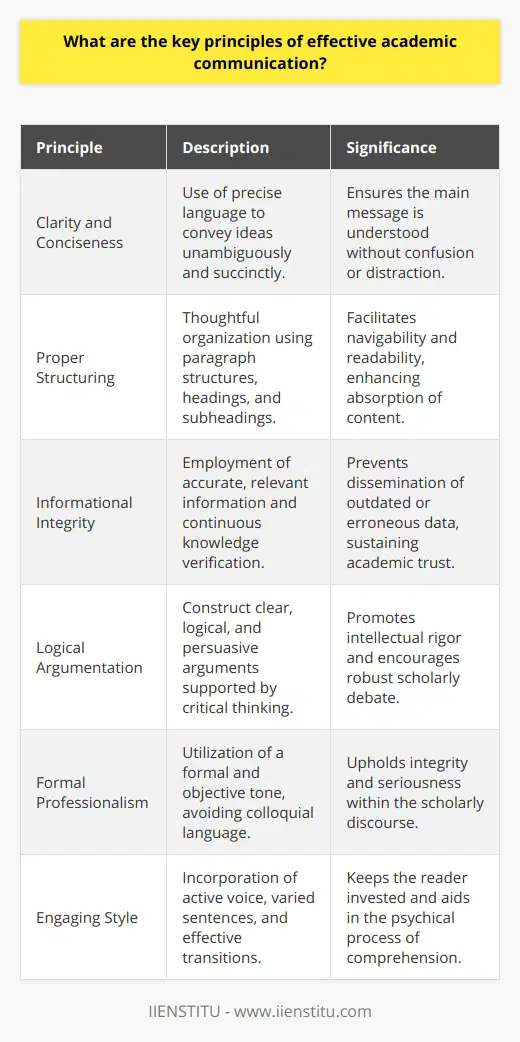
In what ways can understanding one's audience enhance the effectiveness of academic communication?
Role of Audience Understanding in Academic Communication
Academic communication is a critical component of scholarly work, and effectively conveying ideas, research findings, or arguments is essential to creating a robust academic discourse. Understanding one's audience is a crucial factor in enhancing the effectiveness of this communication. In this context, academic communication refers to discourse in a blog post format.
Adapting Content to Reader Expectations
The first way in which understanding one's audience can enhance academic communication is by helping the author adapt the content to meet reader expectations. Being aware of the background knowledge, expertise level, and interests of the audience allows the author to present the information in a manner that aligns with their needs. Providing context, avoiding jargon or technical terms, and focusing on the most relevant information will make the content more accessible and engaging for the target audience.
Improving Clarity and Conciseness
Understanding one's audience also contributes to improved clarity and conciseness in academic communication. A clear understanding of the reader's viewpoint helps the author ensure that the message is presented in a straightforward and coherent manner. With this insight, the author can also eliminate redundancies, repetition or lengthy explanations, thereby making the blog post concise and easier to comprehend.
Enhancing Reader Interest and Engagement
A well-informed assessment of the audience's preferences and expectations leads to increased reader interest and engagement with the blog post. By knowing the audience, the author can tailor the content to be more intriguing and thought-provoking, making it more likely for the reader to stay engaged throughout the post. Moreover, addressing specific concerns or questions that the target audience is likely to have can further enhance this engagement.
Facilitating Persuasive Communication
In instances where academic communication aims to persuade the audience, understanding their views, biases, and potential objections is critical to crafting compelling arguments. Acknowledging and addressing counter-arguments, presenting evidence that resonates with the audience's beliefs, and appealing to their values or emotions can establish credibility and trust, ultimately making the argument more effective.
In conclusion, understanding one's audience plays a pivotal role in enhancing the effectiveness of academic communication through blog posts. By adapting the content to reader expectations, improving clarity and conciseness, enhancing reader interest and engagement, and facilitating persuasive communication, authors can create blog posts that effectively transmit their ideas and contribute to the academic discourse.
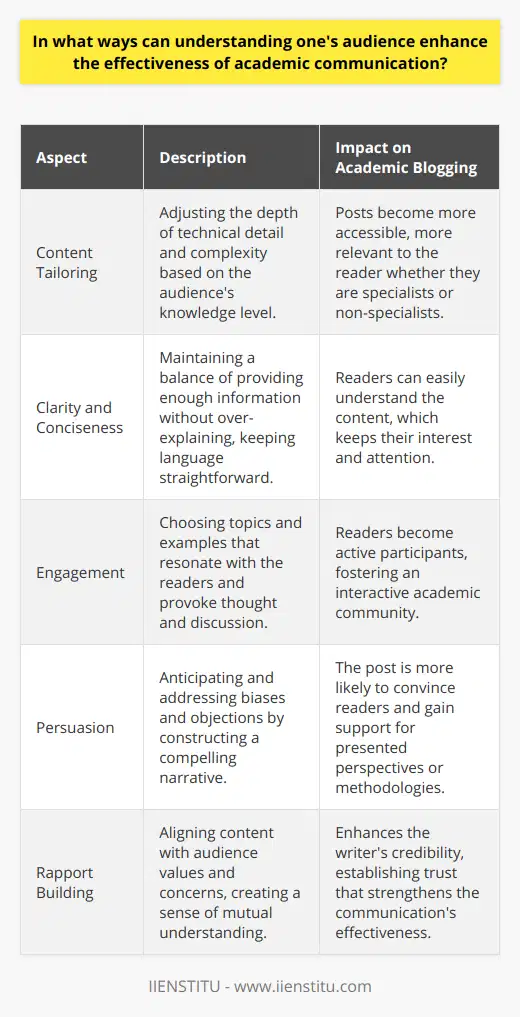
What are the 5 basic communication skills?
Five Fundamental Communication Skills
**Effective Listening**
The first basic communication skill is effective listening. This involves not only hearing what the speaker is saying, but also understanding the intent behind their words. By paying full attention to the speaker, asking clarifying questions, and paraphrasing to ensure correct understanding, one can practice effective listening.
**Verbal Communication**
The second essential skill is verbal communication. Assertiveness, clarity, and conciseness are crucial components of this skill. One should consider the choice of words, tone, and volume to ensure that the message is conveyed clearly and effectively, while also respecting the listener's perspective.
**Nonverbal Communication**
Thirdly, nonverbal communication plays a vital role in conveying messages. Body language, gestures, posture, and facial expressions can provide additional information as well as reinforce or, in some cases, contradict verbal messages. Being aware of one's own nonverbal cues, as well as interpreting those of others, enhances communication effectiveness.
**Written Communication**
The fourth key communication skill is written communication, which includes crafting clear, concise, and well-organized messages, such as emails, reports, or blog posts. Strong written communication skills are critical for conveying information accurately and professionally, particularly in academic and professional settings.
**Empathy and Emotional Intelligence**
Finally, empathy and emotional intelligence are crucial for effective communication. Understanding one's own emotions and being sensitive to the emotions of others is essential in building rapport, resolving conflicts, and fostering cooperation. This skill involves recognizing and managing one's emotions, as well as empathizing with others and responding in an appropriate, respectful manner.
In conclusion, the five basic communication skills, including effective listening, verbal communication, nonverbal communication, written communication, and empathy and emotional intelligence, are essential for successful interaction in a variety of contexts. By developing and refining these skills, one can improve their ability to express themselves and deeply understand others, enhancing both personal and professional relationships.
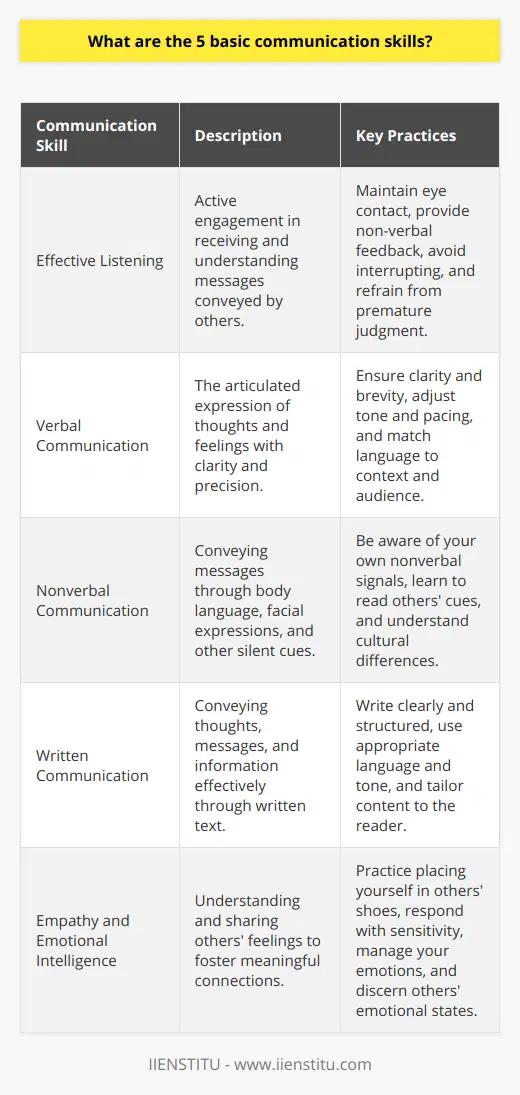
How do you demonstrate good communication skills in an academic setting?
Effective Listening
To demonstrate good communication skills in an academic setting, one should first focus on effective listening. This involves attentively paying attention to the speaker and refraining from interrupting or getting distracted. Active listening techniques, such as paraphrasing or asking questions for clarification, can enhance understanding and contribute to a more fruitful discussion.
Articulate Expression
Secondly, articulate expression of ideas and opinions is crucial for good communication. This can be achieved by organizing thoughts, using clear and concise language, and ensuring that the message is tailored to the audience's needs. When speaking, make use of appropriate facial expressions, gestures, and tone of voice to convey the intended meaning.
Constructive Feedback
Another essential component of good communication in an academic setting is providing constructive feedback. This includes acknowledging the value of diverse perspectives, critiquing ideas without criticizing the person, and offering specific suggestions for improvement. It is also important to receive feedback graciously, as this shows a willingness to learn and engage in collaborative discussions.
Cultural Sensitivity
Being aware of and sensitive to cultural differences is a critical aspect of effective communication. In an academic environment, this involves showing respect for diverse beliefs, values, and ways of thinking that may differ from one's own. Demonstrating empathy and trying to understand others' perspectives can lead to more productive interactions and strengthen relationships.
Written Communication
Lastly, strong written communication skills are crucial in an academic setting. This means crafting well-structured and grammatically accurate pieces of writing. Additionally, one should use a coherent and logical argumentation while avoiding jargon and overly complicated language. Proofreading and revising are also essential steps to ensure that the message is clear and organized.
In conclusion, good communication skills in an academic setting encompass active listening, articulate expression, constructive feedback, cultural sensitivity, and proficient written communication. By mastering these skills, individuals can enhance their academic experience, build healthy relationships, and contribute to a more inclusive and collaborative learning environment.
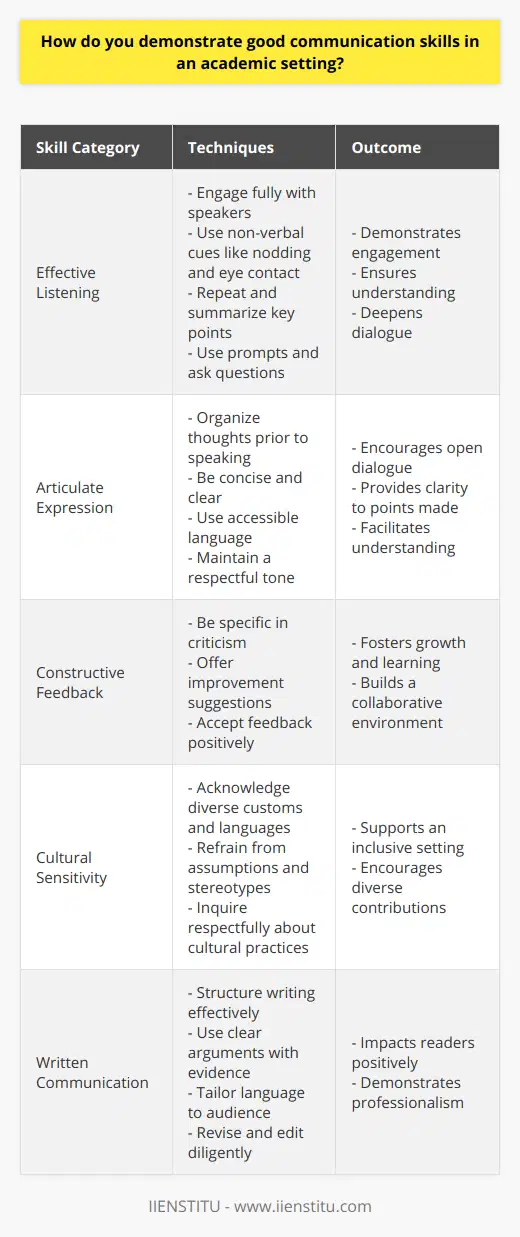
How can one adapt their communication style to suit various academic contexts and situations?
Understanding Different Academic Contexts
Adapting one's communication style to suit various academic contexts and situations is essential for effective communication, collaboration, and knowledge sharing. To achieve this, one must first understand the specific characteristics and expectations of each context, such as lectures, seminars, group discussions, research projects, and presentations.
Active Listening and Informed Participation
In lecture settings, active listening and taking concise notes are crucial. Attentiveness allows capturing of essential information while demonstrating respect for the lecturer. Seminars, on the other hand, require informed participation. Engaging in active dialogue, asking relevant questions, and providing constructive feedback help create a stimulating learning environment.
Appropriate Language and Tone
Using appropriate language and tone is essential when communicating with peers, instructors, and researchers. In formal contexts, use technical terms and precise language, avoid colloquial expressions, and maintain a respectful tone. In informal settings, conversational language and relaxed tone can encourage open discussions and promote knowledge exchange.
Tailoring Communication to the Audience
Understanding the audience's background, knowledge level, and expectations is crucial to tailoring communication effectively. When presenting complex ideas to a general audience, simplify concepts and use comprehensible examples. Conversely, when communicating with experts, provide more in-depth analyses and employ discipline-specific terminology.
Collaborative Interaction in Group Work
When working in collaborative environments, such as group projects or discussions, effective communication becomes essential. Actively contribute ideas, listen carefully to others' input, and offer constructive feedback. Moreover, consider the strengths and weaknesses of group members to delegate tasks effectively and ensure the overall success of the project.
Embracing Digital Communication Tools
In today's ever-evolving academic landscape, familiarity with digital communication tools is vital. Utilize collaboration platforms, such as shared documents and virtual meetings, to share information, updates, and feedback with colleagues, instructors, and research team members.
In conclusion, adapting communication styles to suit various academic contexts requires understanding the characteristics and expectations of each situation, listening actively, participating thoughtfully, using appropriate language and tone, tailoring messages to the audience, engaging in collaborative interactions, and embracing digital communication tools. By mastering these elements, one can become an effective communicator in diverse academic settings, fostering thriving communities of learning and research.
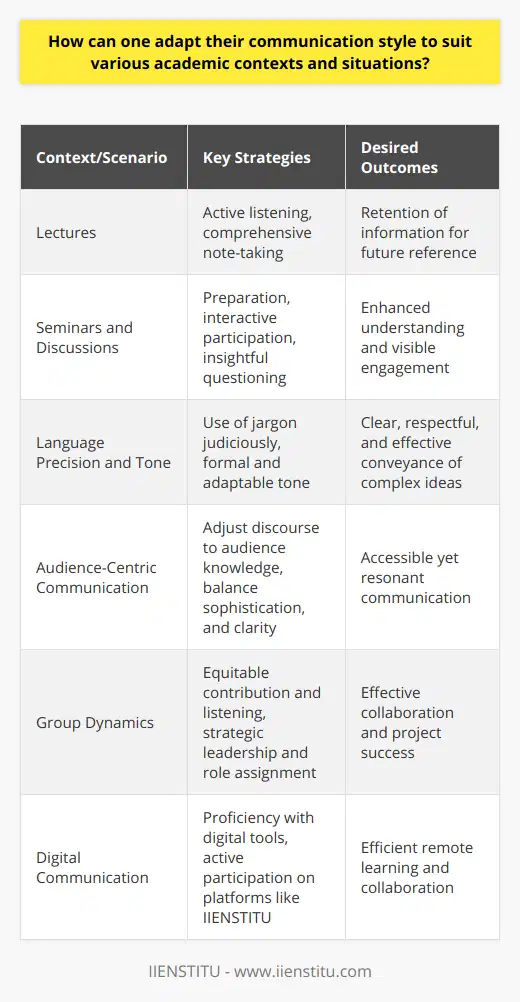
What role does nonverbal communication play in academic settings and how can it be improved?
Role of Nonverbal Communication in Academic Settings
Nonverbal communication significantly impacts how students and educators exchange information and ideas in academic settings. This form of communication can involve facial expressions, body language, gestures, tone of voice, and even the physical space between individuals. In classrooms, nonverbal communication has the potential to enhance student engagement, improve understanding, and create a positive learning environment.
Enhancing Student Engagement
Educators can leverage various nonverbal cues to gauge interest, promote critical thinking, and foster active participation. For example, maintaining eye contact with students can demonstrate attentiveness, while adopting a relaxed and open body posture can encourage inclusiveness. Furthermore, meaningful gestures can help clarify complex concepts and emphasize key points in lectures or discussions.
Improving Understanding
Incorporating visual aids, such as graphs, diagrams, and images, can aid in conveying information more effectively. Visual aids can supplement verbal explanations, particularly when dealing with complex or abstract ideas. Additionally, educators can modulate their tone of voice to emphasize important points or convey enthusiasm, which can help students better retain information.
Creating a Positive Learning Environment
Nonverbal communication can also contribute to creating a supportive and respectful learning space for students. For instance, maintaining an appropriate distance between the educator and students can convey respect for personal boundaries. Similarly, educators can use facial expressions and body language to show empathy, understanding, and encouragement, thereby creating a more psychologically safe and comfortable learning environment.
Improving Nonverbal Communication Skills
Both educators and students can benefit from developing their nonverbal communication skills. Techniques to improve nonverbal communication include practicing active listening, becoming aware of personal body language, and intentionally using facial expressions and gestures to convey meaning. Moreover, using video recordings or seeking feedback from peers can help individuals identify areas for improvement and refine their nonverbal communication strategies.
In summary, nonverbal communication plays a critical role in academic settings, influencing student engagement, understanding, and overall learning atmosphere. By honing these skills, both educators and students can contribute to a more effective and positive academic experience.
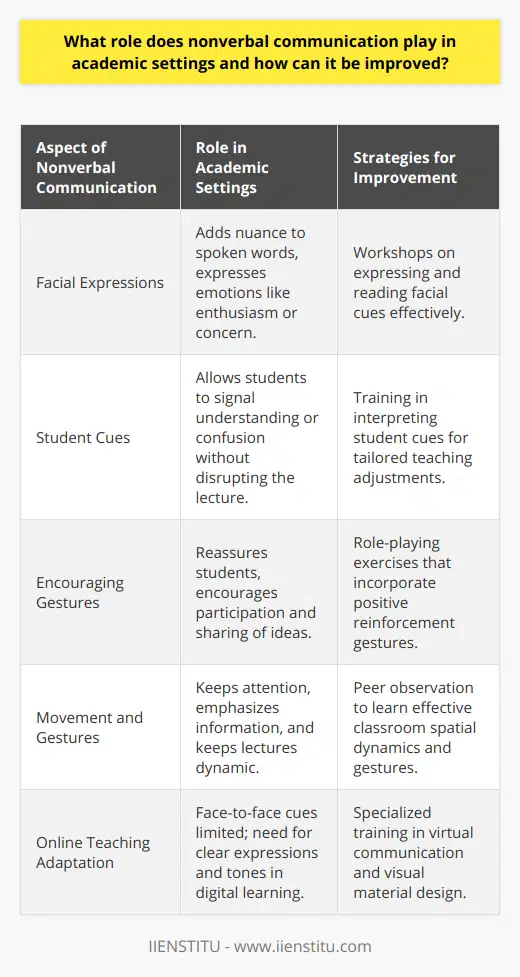
How can technology be utilized to enhance communication skills within an academic context?
Integrating Technology in the Classroom
Technology can be effectively utilized to enhance communication skills within an academic context by integrating various digital tools into the learning process. This integration can prove beneficial in promoting active student engagement, fostering collaboration, and providing diverse learning opportunities.
Promoting Active Student Engagement
Incorporating communication technologies such as discussion forums, e-mails, and instant messaging can create an interactive environment for students to ask questions and share ideas. Providing learners with a platform to voice their thoughts encourages them to actively participate in discussions, thereby strengthening their communication skills. Moreover, the asynchronous nature of these technologies enables students of different backgrounds and time zones to engage in conversation without restrictions.
Fostering Collaboration and Group Work
Project-based learning, facilitated through digital tools, encourages students to work together and engage in collaborative problem solving. Online platforms such as Google Docs, Trello, and Moodle allow students to collaborate, delegate responsibilities, and monitor progress in real-time. These solutions foster teamwork and enhance communication skills by enabling students to articulate their thoughts effectively, negotiate ideas, and work towards achieving a collective goal.
Diversifying Learning Opportunities
Expanding course materials to include multimedia resources such as videos, podcasts, and interactive presentations can expose students to varied content delivery methods and improve their multimedia literacy. Encouraging learners to create their media content, such as blog posts, short films, or podcasts, can also improve communication skills. Students can develop the ability to convey information concisely, coherently, and persuasively through different media channels.
Facilitating Peer Review and Feedback
Embracing digital platforms that enable peer review and feedback processes empowers students to critically evaluate their work and that of others. Leveraging technology, such as Turnitin, allows learners to assess content originality, while platforms like Edmodo and VoiceThread facilitate in-depth qualitative feedback. Receiving constructive criticism from peers enables students to identify areas for improvement, ultimately enhancing their communication abilities.
In summary, integrating technology into the academic context yields substantial benefits in developing students' communication skills. As global connectivity continues to grow, adapting to digital communication tools will further prepare students for success in their professional and personal lives.
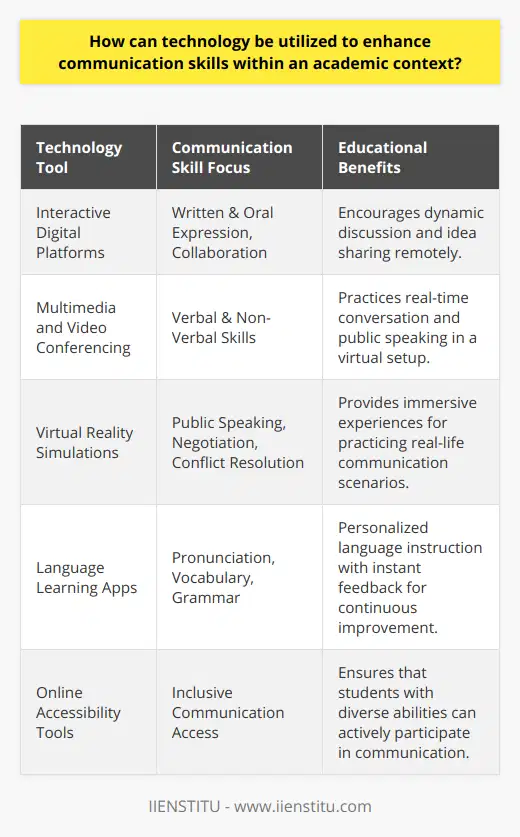
What strategies can be employed to promote effective group communication in collaborative academic projects?
Establishing Clear Goals and Roles
To promote effective group communication in collaborative academic projects, it is essential to establish clear goals and roles for each team member. By explicitly defining the objectives and assigning specific tasks to individuals, it ensures that everyone understands their responsibilities, decreases confusion, and fosters accountability.
Creating Open Communication Channels
To facilitate smooth interaction among team members, open communication channels are vital. These channels can include regular team meetings, emails, texts, or group chat platforms. By actively encouraging each member to express their thoughts, ideas, and concerns without fear of judgment, it creates an environment that nurtures creativity, fosters trust, and promotes better team relationships.
Promoting Active Listening
In collaborative academic projects, it is paramount that team members actively listen to one another with respect and patience. By being present, attentive, and engaged when others are speaking, it allows for a clear exchange of ideas, discourages misunderstandings, and cultivates an atmosphere of cooperation.
Encouraging Constructive Feedback
To foster learning and growth in a collaborative setting, constructive feedback is necessary. Rather than criticizing others harshly or shutting down their ideas, team members should provide specific suggestions to improve or modify project components. Welcoming feedback and criticism with an open mind will strengthen team dynamics and improve the final result.
Utilizing Team-building Activities
Implementing team-building activities can improve group communication by strengthening the bonds among members and increasing their understanding of one another's strengths and weaknesses. Whether it is through group exercises or informal social gatherings, these activities will help build trust, boost morale, and create a strong, cohesive team capable of effectively working together.
Reflecting and Adapting
Finally, the ability to reflect and adapt in response to challenges and setbacks is key to successful group communication. Regularly reviewing and evaluating the team's progress, identifying areas for improvement, and adapting the communication strategies will ensure project objectives are met effectively and efficiently.
In conclusion, strategies that promote effective group communication in collaborative academic projects include establishing clear goals and roles, creating open communication channels, promoting active listening, encouraging constructive feedback, utilizing team-building activities, and reflecting and adapting. By implementing these strategies, team members can work together more effectively, leading to higher quality outcomes in academic projects.
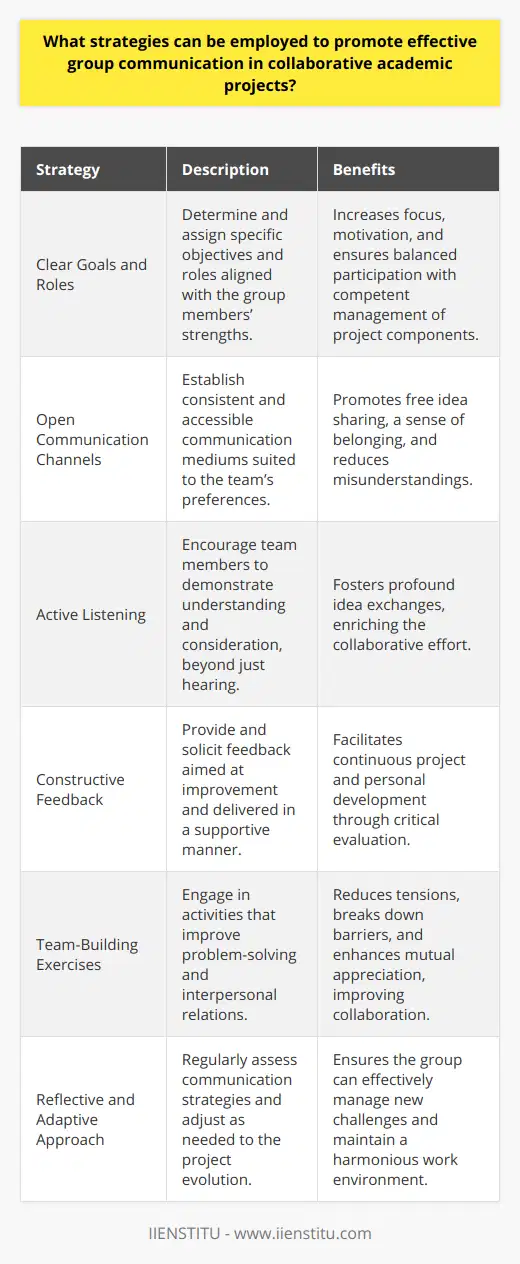
How does one effectively incorporate rhetorical strategies in academic communication?
Understanding Rhetorical Strategies
To effectively incorporate rhetorical strategies in academic communication, one must first understand the three primary rhetorical strategies: ethos, pathos, and logos. When deploying these strategies, it is essential to balance their use within one's writing or presentation, as over-reliance on one strategy may weaken the overall persuasiveness of the message.
Ethos: Establishing Credibility
Ethos refers to the ethical appeal or credibility of the communicator. Building credibility is crucial in academic communication, as it demonstrates to readers the author's competence, authority, and trustworthiness. To establish ethos, the communicator should ensure that their writing is based on solid evidence, research, and expert opinions. Additionally, adopting a clear and precise writing style can enhance the author's credibility.
Pathos: Engaging the Audience's Emotions
Pathos refers to the emotional appeal of the message and seeks to engage the audience by evoking their emotions. While emotions might not seem important in academic communication, connecting with the audience on an emotional level can increase the impact of your message. To incorporate pathos, an author may use anecdotes, personal experiences, or vivid examples to create an emotional response from the reader. However, it is important to use emotion carefully and tactfully, as excessive emotion can detract from an academic argument.
Logos: Employing Logical Argumentation
Logos, the third rhetorical strategy, refers to the logical appeal or the process of persuading the audience through logical argumentation and reasoning. In academic communication, logos is arguably the most important of the three strategies, as it forms the foundation of any credible argument. To apply logos in your writing, it is essential to present a clear and well-organized argument based on evidentiary support, such as facts and data. Additionally, ensure that all claims are thoroughly explained and supported with relevant evidence, as this can demonstrate the logical coherence of your argument.
Balancing Rhetorical Strategies
Incorporating each of the rhetorical strategies within academic communication is crucial in creating a well-rounded and persuasive message. By establishing credibility with ethos, engaging the audience's emotions with pathos, and presenting a logical argument with logos, an academic communicator can enhance the effectiveness of their message. Furthermore, being mindful of the balance between these strategies can help to prevent over-reliance on a single approach and contribute to the overall persuasiveness of your academic communication.
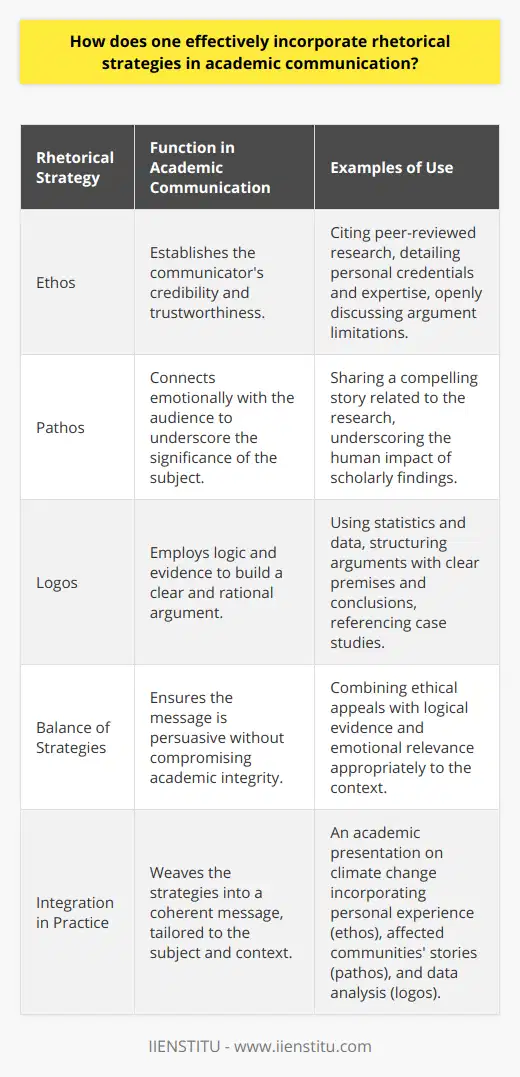
What are the barriers to effective communication in an academic setting and how can they be overcome?
Cultural and Linguistic Differences
One of the primary barriers to effective communication in an academic setting is the cultural and linguistic differences among students and faculty. This can result in misunderstandings, confusion, and a lack of inclusivity. To overcome this barrier, institutions can offer language courses or workshops to improve the linguistic proficiency of their community members. Additionally, establishing cultural awareness programs and encouraging open dialogue about cross-cultural experiences can foster understanding and respect.
Limited Access to Communication Channels
In some cases, students and faculty may not have equal access to communication channels, such as email or online platforms, hindering their ability to engage in discussions and share information. Ensuring that all community members have access to essential communication tools, including providing technical support and training, is crucial to promoting effective communication. Institutions should also consider offering alternative communication methods, such as live chat or video conferencing, to accommodate diverse needs.
Different Communication Styles
Another issue that often arises in an academic setting is the variety of communication styles among individuals. Some people may prefer direct communication, while others may opt for a more diplomatic approach. Understanding and accommodating these differences are essential to foster a healthy, collaborative environment. Offering workshops on effective communication and interpersonal skills can help individuals adapt their styles to communicate better with their peers and colleagues.
Time Constraints and Workload Pressure
Academic settings often come with significant time constraints and workload pressure, which can lead to rushed or incomplete communication. To overcome this barrier, institutions can encourage time management skills and prioritize effective communication by providing training sessions on efficient communication methods. Faculty and students can also employ strategies such as setting clear agendas for meetings, using templates for written communication, and setting deadlines for responses to ensure clarity and maintain channels open.
In conclusion, overcoming barriers to effective communication in an academic setting involves addressing cultural and linguistic differences, ensuring access to communication channels, adapting communication styles to the diverse needs of individuals, and managing time constraints and workload pressure. By taking these steps, schools and universities can foster open dialogue, encourage collaboration, and create a more inclusive environment for all members of their community.
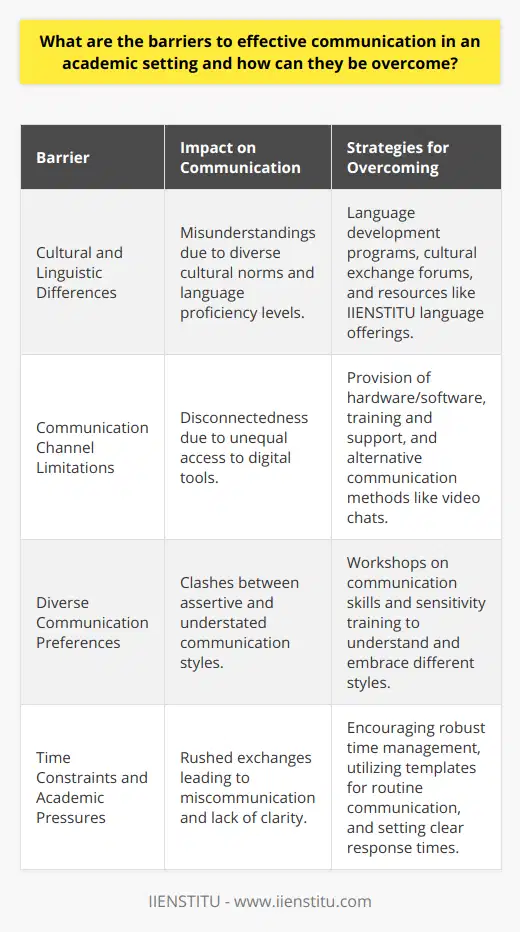
How can interdisciplinary communication be fostered in academic institutions to enhance collaboration and knowledge exchange?
Creating an Interdisciplinary Environment
Interdisciplinary communication is crucial in academic institutions to enhance collaboration and knowledge exchange. Integrating various disciplines enables innovation and facilitates a better understanding of complex issues. To foster interdisciplinary communication in academic institutions, several measures can be taken.
Enabling Platform for Exchange
First, academic institutions can establish platforms promoting interdisciplinary interaction. Online forums, workshops, and conferences can provide opportunities for faculty and students from different disciplines to share their research and foster interdisciplinary collaborations. Developing a space for open discourse encourages brainstorming, networking, and the exchange of ideas.
Curriculum Integration
Incorporating interdisciplinary courses into the curriculum is another vital step. By designing courses that combine multiple disciplines, students are exposed to a diversity of perspectives and gain the skills necessary for interdisciplinary communication. Such curricula should encourage critical thinking, problem-solving, and teamwork, which are essential in cultivating a culture of collaboration among students.
Faculty Collaboration
Supporting faculty collaboration is also crucial for interdisciplinary communication. Encouraging interdisciplinary research projects and providing necessary resources for joint research initiatives can lead to productive collaborations between faculty from different disciplines. In addition, institutions should create incentives for faculty to engage in interdisciplinary work, such as funding opportunities and recognition of collaborative achievements.
Student Involvement
Engaging students in interdisciplinary activities is crucial for fostering a culture of interdisciplinary communication. Institutions can organize extracurricular events, such as hackathons or case competitions, that require interdisciplinary teams to create innovative solutions. Providing opportunities for students to participate in research projects or internships that cut across disciplinary boundaries is essential in promoting an interdisciplinary mindset among the future generation of academics.
Continuous Evaluation and Adaptation
Lastly, continuous evaluation and adaptation of interdisciplinary initiatives is essential to gauge their effectiveness in fostering communication and collaboration. Institutions should regularly assess the outcomes of interdisciplinary programs, courses, and events, and utilize student and faculty feedback to make necessary changes to improve the interdisciplinary environment.
In conclusion, fostering interdisciplinary communication in academic institutions involves creating platforms for exchange, integrating interdisciplinary courses, promoting faculty collaboration, engaging students in interdisciplinary activities, and evaluating the success of such initiatives. Implementing these measures will enhance collaboration and knowledge exchange, leading to innovative solutions to complex issues and driving academic progress.
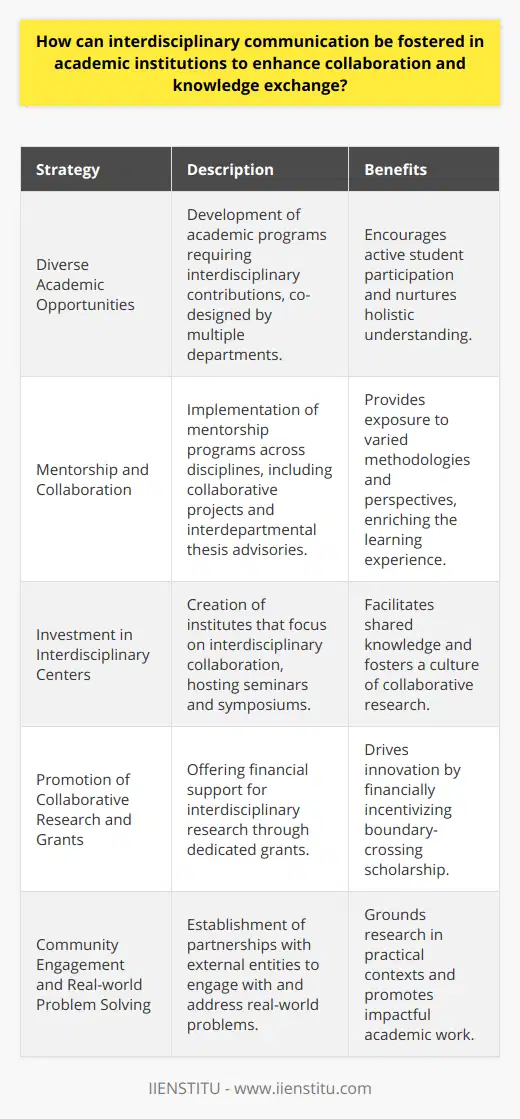
What are the essential components of nonverbal communication in an academic context?
Understanding Nonverbal Communication in Academia
Nonverbal communication in an academic context consists of various components that hold significant value in facilitating effective communication. In this paragraph, we will discuss the essential components of nonverbal communication in an academic setting. These components are essential in ensuring that the intended message is effectively conveyed.
Facial Expressions and Eye Contact
One of the major components of nonverbal communication is facial expressions, which convey emotions and reactions during conversations. In an academic context, sharing ideas and information often requires speakers to express their emotions, such as approval or disapproval, through facial expressions. Moreover, maintaining eye contact signifies active participation in discussions, as it establishes a connection between the communicator and the recipient and projects confidence in the information being conveyed.
Gesture and Posture
Gesture is another crucial component of nonverbal communication, especially in academic settings. It involves using hand gestures, movements, and body language to emphasize and support the verbal message being delivered. Similarly, posture plays a significant role in expressing the speakers' level of confidence and attentiveness. Adopting an upright and open posture reflects a positive attitude and engages the audience more effectively.
Proximity and Personal Space
Maintaining an appropriate level of proximity helps establish a connection and rapport with the audience, while respecting their personal space. In academia, maintaining a suitable distance from the audience permits an open and comfortable exchange of ideas, encouraging active participation and discussion.
Paralinguistics: Tone and Pitch of Voice
Paralinguistic elements, such as tone of voice and pitch, significantly impact the delivery of information in academic settings. The speaker’s modulation and intonation can emphasize critical points and engage the audience effectively. A well-balanced tone and pitch reflect confidence and command over the subject, resulting in better comprehension by the audience.
In conclusion, the essential components of nonverbal communication in academic contexts work in tandem with verbal communication to deliver an effective and comprehensive message. Ensuring appropriate facial expressions, eye contact, gestures, posture, proximity, and paralinguistic elements helps foster a conducive environment for a productive exchange of ideas, ultimately contributing to the personal and collective growth of individuals engaged in academic discourse.
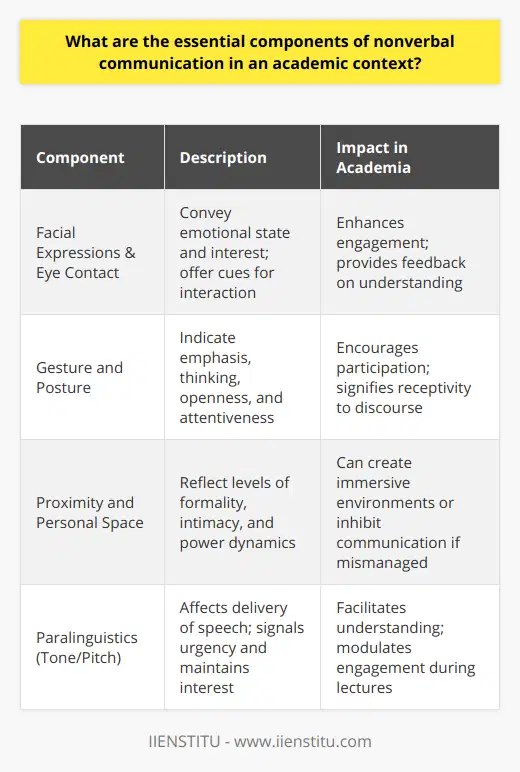
How can one effectively navigate and address communication challenges arising from linguistic diversity in academic settings?
Developing Communication Skills
One key approach to effectively navigate and address communication challenges arising from linguistic diversity in academic settings is by developing strong communication skills. Such skills include active listening, clear expression of thoughts, and the ability to adapt one's communication style to the listener's needs.
Utilizing Translation Tools
Another strategy is the use of translation tools to promote understanding among individuals who speak different languages. These tools can range from online dictionaries and translators to professional interpreters, assisting in the comprehension of written and spoken communication.
Emphasizing Language Learning
Emphasizing the importance of language learning in academic settings can also mitigate communication challenges. Offering language classes and incorporating language exchange programs can help individuals enhance their linguistic abilities and widen their understanding of diverse communication styles.
Cultural Awareness and Sensitivity
Building cultural awareness and sensitivity among members of an academic community fosters an inclusive environment where individuals from different linguistic backgrounds feel comfortable sharing their ideas. This involves understanding cultural nuances, avoiding stereotypes, and respecting customs and traditions outside of one's own culture.
Inclusive Teaching Strategies
Educators have a significant role to play in addressing linguistic diversity. Implementing inclusive teaching strategies such as using plain language, avoiding jargon, providing visual aids, and offering more breaks during class discussions can make content more accessible to students who may struggle with language proficiency.
Collaboration and Teamwork
Lastly, promoting collaboration and teamwork within the academic setting can also help overcome language barriers. By assigning group projects or encouraging informal discussions, students have the opportunity to practice communication skills, learn from their peers, and develop their intercultural competence.
In conclusion, effectively navigating and addressing communication challenges arising from linguistic diversity in academic settings involves a comprehensive approach that includes strengthening communication skills, using translation tools, encouraging language learning, fostering cultural sensitivity, employing inclusive teaching methods, and promoting collaboration. By implementing these strategies, academic communities can create an inclusive learning environment that accommodates the diverse linguistic needs of their members.
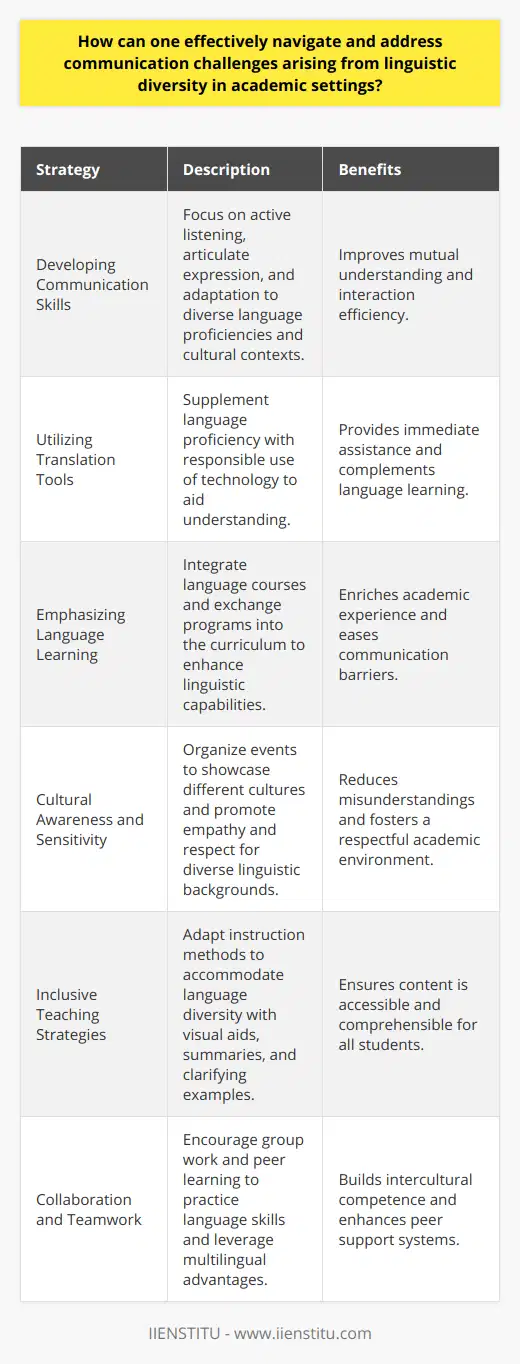
What is the role of empathy and active listening in facilitating effective communication within academic environments?
Empathy's Role in Effective Communication
Empathy and active listening are interconnected skills that play a crucial role in fostering effective communication within academic environments. Empathy is the ability to understand another person's feelings, thoughts, and perspectives, while active listening involves consciously focusing on the speaker and processing their message. These skills are essential in academic settings because they create an atmosphere of trust, mutual understanding, and openness, which ultimately leads to more productive conversations and collaboration.
Enhancing Mutual Understanding
In academic environments, empathy and active listening are particularly important because they facilitate mutual understanding among individuals with diverse backgrounds, perspectives, and expertise. Such diversity is fundamental to the process of research, learning, and problem-solving. When empathy and active listening are practiced consistently, they help to create a bridge between differing viewpoints, fostering an environment in which individuals feel valued and are more inclined to contribute constructively to academic discussions.
Encouraging Openness and Trust
The presence of empathy and active listening in academic communication also leads to greater openness and trust between individuals. By demonstrating genuine care and understanding toward others, individuals establish more positive connections, which can result in increased collaboration and team cohesion. Trust and openness cultivated through empathetic communication are vital for successful academic projects, as they enable individuals to share ideas, perspectives, and feedback comfortably, leading to richer and more nuanced results.
Reducing Miscommunication and Conflict
Furthermore, empathy and active listening help to reduce miscommunication and conflict within academic environments. By focusing on understanding and supporting another person's viewpoint rather than imposing one's own opinion, individuals are more likely to resolve disagreements positively. Active listening enables people to ask relevant questions, clarify misunderstandings, and provide appropriate feedback, which, in turn, minimizes the likelihood of misinterpretation. Thus, empathy and active listening contribute to a more harmonious and cohesive academic environment, which is essential to achieving joint goals.
Conclusion
In conclusion, empathy and active listening are essential components of effective communication within academic settings. By fostering mutual understanding, openness, trust, and reducing miscommunication and conflict, these skills contribute to a healthier and more productive environment conducive to learning, research, and collaboration. Therefore, nurturing empathy and active listening should be a priority for individuals in academia in order to facilitate meaningful dialogue and successful outcomes.

What category of skill is communication?
Defining Communication Skills
Communication, an essential aspect of human interaction, is primarily described as a transfer of information between individuals or groups. It encompasses verbal and non-verbal exchanges while enabling people to effectively express thoughts, ideas, and emotions. In terms of skill categorization, communication skills fall under the broad category of soft skills.
Soft Skills: A Crucial Categorization
Soft skills, also known as interpersonal or people skills, are a set of attributes that facilitate interactions and collaborations. These are essential for building relationships, conveying ideas, and achieving personal or professional success. The distinction between soft and hard skills is that the latter refers to objective technical or specific abilities, usually learned and measurable. In contrast, soft skills involve subjective aspects that are harder to quantify.
Core Components of Communication Skills
Several sub-skills contribute to effective communication, further supporting its classification as a soft skill. These include, but are not limited to:
Active listening: This involves attentively and openly receiving information from others without interrupting or judging, thereby encouraging meaningful exchanges.
Empathy: The ability to understand and share the feelings of others, fostering a deeper connection and rapport.
Non-verbal signals: The use of gestures, eye contact, and facial expressions to convey messages and emotions, playing a crucial role in complementing verbal communication.
Clarity and conciseness: The art of articulating ideas and messages clearly and succinctly to prevent misunderstandings and ensure proper comprehension.
Feedback and adaptability: Providing constructive feedback and being open to receiving it, as well as adapting communication styles according to various situations and individuals.
Importance of Communication Skills in Various Contexts
Effective communication skills are indispensable in both personal and professional spheres. In the workplace, they enhance team dynamics, foster collaboration, ensure efficient problem-solving, and minimize conflicts. Similarly, in personal relationships, strong communication skills facilitate mutual understanding, trust, and conflict resolution.
In conclusion, communication skills are best categorized as soft skills, given their subjective nature and crucial role in interpersonal interactions. Developing this vital set of abilities can significantly impact personal and professional success and further cultivate meaningful connections with others.
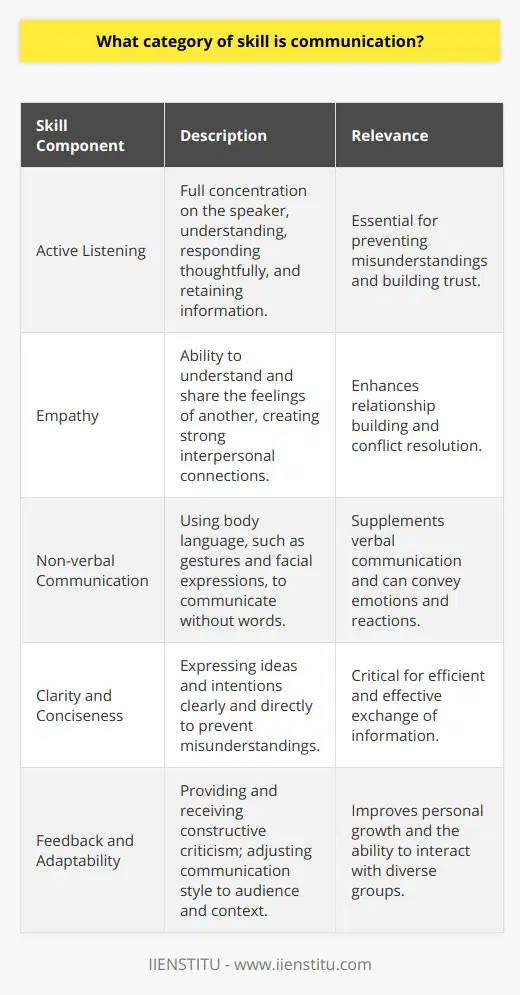
How do you say you have good communication skills on a resume?
Highlighting Communication Abilities
In order to effectively convey one's strong communication skills on a resume, it is crucial to go beyond merely listing 'good communication skills' as a qualification.
Demonstrating Written Communication Proficiency
A tangible indicator of excellent written communication is the resume itself. Through concise, well-structured sentences and coherent content organization, a resume can showcase the applicant's ability to articulate thoughts clearly. In addition, providing specific instances where written communication played a vital role in achieving success, such as drafting professional reports or creating engaging marketing materials, can further bolster this claim.
Showcasing Verbal Communication Skills
Similar to written communication, sharing examples of situations where verbal communication played a key role in the candidate's success can substantiate their expertise. Examples may include facilitating meetings, giving presentations, or negotiating with clients. Furthermore, mentioning additional language proficiencies, if applicable, will illustrate an ability to communicate effectively in various linguistic contexts.
Illustrating Interpersonal Communication Prowess
Interpersonal communication skills, also known as people skills or soft skills, are crucial in fostering positive relationships with colleagues, clients, and stakeholders. To showcase this competency, include experiences that involved teamwork, collaboration, or conflict resolution. For instance, describe projects where effective collaboration with team members was crucial to reaching objectives, or explain how a diplomatic approach resolved a conflict and led to a mutually beneficial outcome.
Emphasizing Active Listening and Adaptability
Strong communication also involves active listening, understanding, and adapting to others' perspectives. Illustrating instances where one has been receptive to feedback, adapted communication strategies based on audience needs, or employed empathy in challenging situations can emphasize these essential skills.
Incorporating Quantifiable Achievements
Including measurable accomplishments that are directly related to communication abilities can provide a final touch to reinforce the claim of possessing strong communication skills. Examples may involve improved customer satisfaction ratings, increased team productivity, or successful completion of projects due to effective communication.
In conclusion, to convey strong communication skills on a resume, one should demonstrate proficiency in written and verbal communication, showcase examples of interpersonal communication prowess, emphasize active listening and adaptability, and incorporate quantifiable achievements that highlight their ability to effectively communicate in various circumstances.
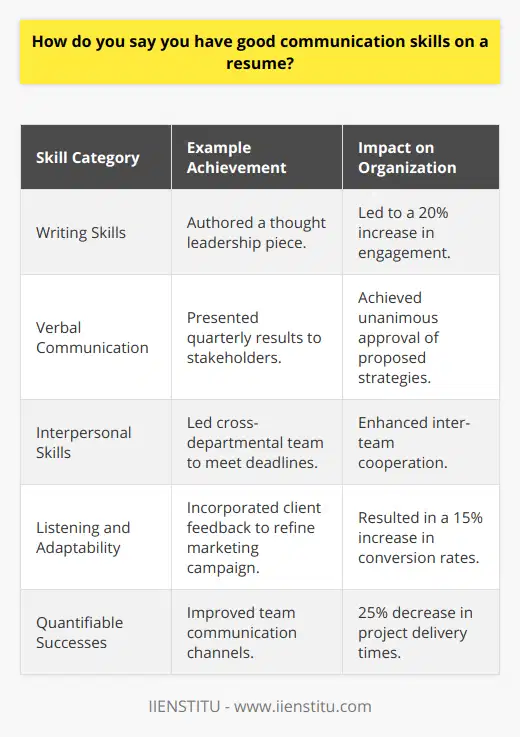
How do cognitive abilities and emotional intelligence intersect in the development and expression of communication skills?
Intersection of Cognitive Abilities and Emotional Intelligence
The intersection of cognitive abilities and emotional intelligence plays a crucial role in the development and expression of communication skills. Cognitive abilities, such as attention, memory, and problem-solving, provide the foundation for understanding and processing information. In contrast, emotional intelligence involves recognizing, understanding, and regulating emotions, both in oneself and in others.
Role of Cognitive Abilities in Communication
Cognitive abilities facilitate the comprehension of verbal and nonverbal cues, which contributes to effective communication. These mental processes enable individuals to digest complex ideas, construct coherent arguments, and adapt messages according to the audience's needs and expectations. Moreover, cognitive skills are critical for the accurate interpretation of ambiguous or contradictory signals, allowing communicators to respond appropriately.
Importance of Emotional Intelligence in Communication
Emotional intelligence adds a vital dimension to communication by fostering empathy, enhancing social awareness, and promoting effective self-expression. Emotionally intelligent individuals can identify the emotional context of a conversation, which empowers them to adjust their communication style accordingly. Consequently, they can prevent misunderstandings, reduce conflicts, and build stronger relationships.
Integration of Cognition and Emotion in Communication
The development and expression of communication skills involve the interplay between cognitive abilities and emotional intelligence, as they work in tandem to facilitate smooth interactions. Cognitive skills enable communicators to process and convey ideas, while emotional intelligence supports the navigation of emotional and social nuances. The integration of these competencies allows individuals to engage in productive and meaningful dialogues.
In conclusion, cognitive abilities and emotional intelligence are intertwined in the development and expression of communication skills. Both elements complement each other in facilitating effective and empathetic communication. Acknowledging and developing this intersection will likely lead to better communication outcomes, enhanced interpersonal relationships, and overall personal growth.
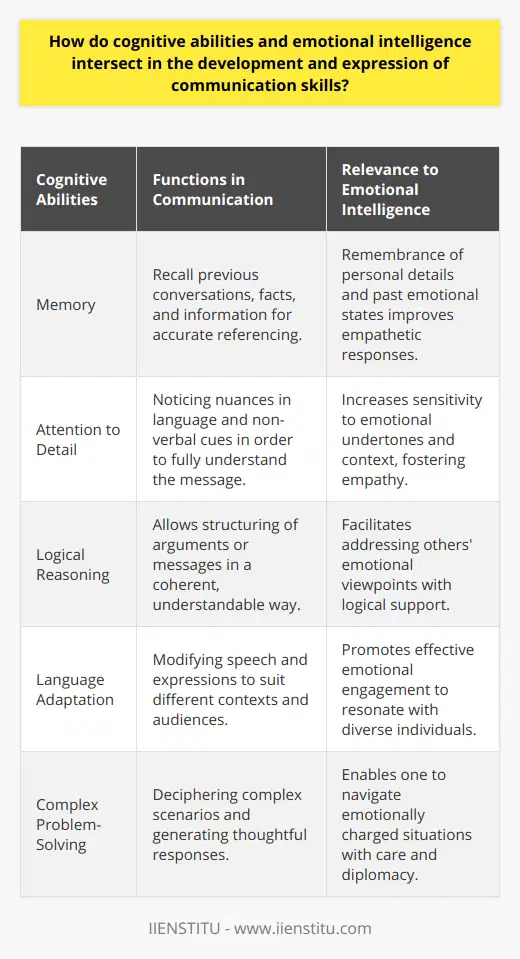
How do you describe communication skills in an academic context?
Understanding Academic Communication
Communication skills, within an academic context, encompass a multi-faceted range of competencies aimed at promoting effective exchange of knowledge and understanding. Primarily, they encompass abilities such as active listening, effective speaking, quality writing, and competent reading.
Active Listening
The first factor, active listening, holds profound importance in academic communication. It's not just about hearing words, but understanding and interpreting them correctly. This skill enhances the process of learning and promotes a well-comprehensive understanding of the subject matter.
Effective Speaking
Next is effective speaking. Being able to convey thoughts and ideas clearly makes information exchange efficient. This involves using the correct language, tone, pitch, and body language. Proper articulation encourages mutual understanding and learning symphony.
Quality Writing
Quality writing, on the other hand, involves creating well-structured, clear and succinct sentences. This enhances readers' understanding, helping to transmit knowledge accurately. It includes academic essays, thesis writing, and report writing. It calls for a keen sense of grammar rules, punctuation and spelling.
Competent Reading
Lastly, competent reading is indispensable for assimilating knowledge. It involves understanding the context, appreciating the viewpoint of the writer, and grasping the underlying message. This skill facilitates the process of learning, critical thinking and knowledge building.
In conclusion, academic communication skills are crucial for effective knowledge exchange. Active listening, effective speaking, quality writing, and competent reading form the core of these skills. Cultivating these skills can significantly enhance learning and understanding in the academic domain.
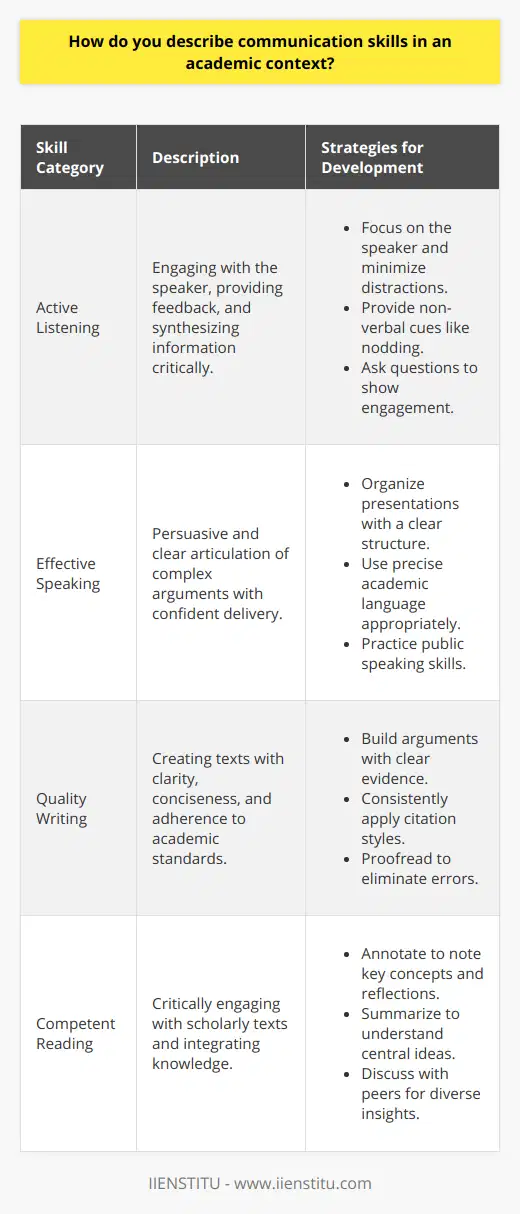
What are the best practices for integrating visual aids and multimedia elements into academic communication?
Understanding Visual Aids in Academic Communication
Effective integration of visual aids and multimedia elements into academic communication requires careful planning and thoughtful implementation. A direct correlation exists between the proper use of these tools and increased understanding of the presented information.
Role of Visual Aids
Visual aids such as graphs, diagrams, charts, and images can enhance comprehension. They summarize complex information into easily understood visuals. It is essential to ensure consistency and clarity in visual aids. The visuals should accurately represent the data. Also, avoid clutter and overcrowding in visual elements.
Value of Multimedia
Multimedia elements include audio clips, videos, or interactive content. These tools can facilitate active engagement among audiences. They also cater to varied learning styles. When using multimedia, consider attention spans, relevance to the topic, and technical considerations like loading time and accessibility.
Integration Practices
Use a balanced approach when integrating visual aids and multimedia elements. These should complement, rather than overshadow, your main content. Be consistent with color schemes, fonts, and styles for cohesion. Always remember to properly reference any external material used.
In conclusion, the best practices for integrating visual aids and multimedia largely center on good planning, careful selection, and proper utilization. To be effective, these tools require intentionality, conscious design decisions, and consistency with the overall communication strategy. Their successful integration can significantly enhance the educational value of academic communication.
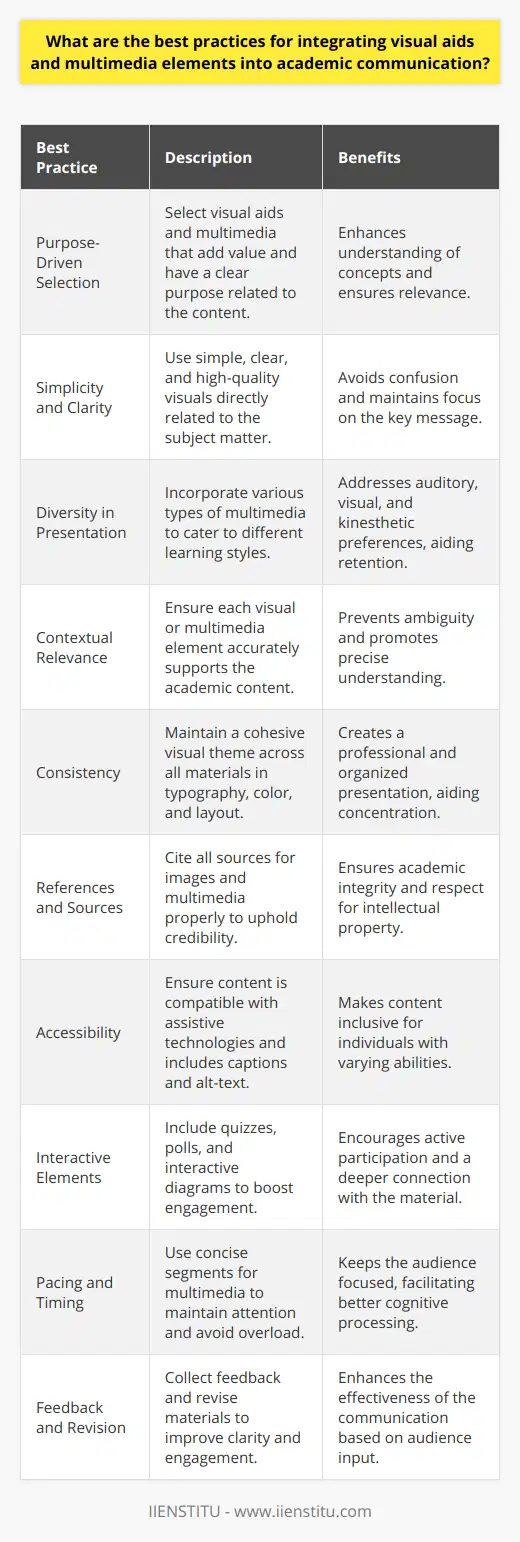
How can critical thinking skills contribute to effective communication and collaborative problem-solving in academic environments?
Role of Critical Thinking in Communication
Critical thinking skills play a significant role in fostering effective communication. These skills enable students to understand, interpret, analyze and evaluate the crux of the conversation or argument objectively. Students can articulate their thoughts more proficiently, allowing them to put forward their opinions and ideas with clarity and conciseness.
Development of Collaborative Problem Solving
Adopting critical thinking in academic environments can pave the way for collaborative problem-solving. Students equipped with critical thinking can identify the strengths and weaknesses of diverse options and perspectives. They can proactively discuss, negotiate, and arrive at solutions that incorporate inputs from all team members, fueling intellectual camaraderie.
Enhancing Academic Performance
Applying critical thinking in communication and problem-solving can ultimately enhance overall academic performance. The students can more accurately comprehend and respond to complex topics. Additionally, they can identify gaps in understanding, request clarifications, and contribute meaningful insights, ensuring a comprehensive grasp of the subject matter.
Conclusion
In conclusion, embedding critical thinking into academic environments can drive effective communication and collaborative problem-solving. It can significantly bolster the students' ability to understand, analyze, and apply knowledge, preparing them for professional life ahead.
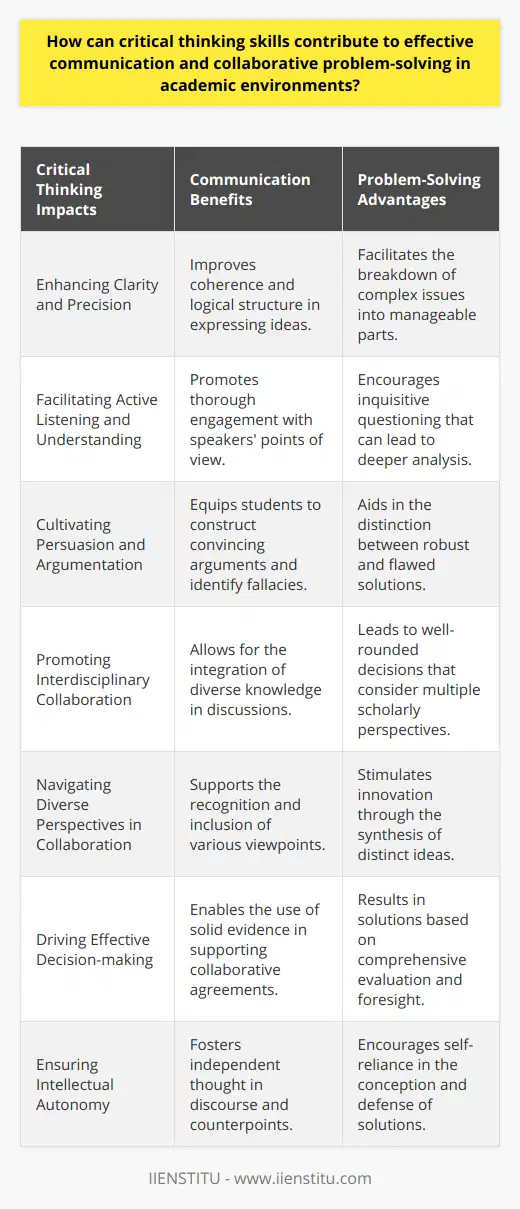
What are the 4 basic communication skills?
Verbal Communication Skills
The first basic communication skill is verbal communication. This refers to expressing ideas, thoughts, and feelings through spoken language. People practice verbal communication virtually in all areas of their daily lives.
Written Communication Skills
The second primary communication skill is written communication. It involves conveying messages through written language or symbols. From emails, articles to reports, in professional settings, written communication plays a significant role.
Non-Verbal Communication Skills
Thirdly, non-verbal communication is a key communication skill. This refers to conveying information without words. It includes body language, facial expressions, and gestures. Often, non-verbal cues can enrich or contradict verbal messages, lending depth to communications.
Listening Skills
The fourth basic communication skill is listening. Listening is a passive skill, implying receiving messages or information from others. Effective listening helps understand others better, thus fostering empathy and mutual respect.
Overall, possessing these four basic communication skills - verbal, written, non-verbal, and listening - can greatly enhance one's ability to interact with others and navigate the world. These skills play an integral role in personal relationships, academics, and professional environments. Regular practice and mindful application of these skills can lead to better understanding and improved communication with others. Efficient communication, in turn, serves as a cornerstone for successful interactions.

How do you describe communication skills in the context of academic discourse and presentation?
Understanding Communication Skills in Academic Discourse
Academic communication skills encompass written and verbal forms of interaction. In academic landscapes, written communication includes research papers, theses, reports, and essays.
Key Elements in Academic Writing
There's a focus on clarity, precision, and detail. The writer employs formal language, avoids colloquial expressions, and uses rigorous referencing. Citations recognize the intellectual contributions of others in the academic community.
Role of Verbal Communication Skills
In presentations, verbal communication skills are vital. Mastery of these skills allows the presenter to engage the audience effectively. They can deliver complex information quickly and efficiently, and captivate their listeners.
Effect of Body Language
Body language also supplements verbal presentations. Non-verbal cues such as eye contact and gestures can increase the effectiveness of the delivery. The presenters use these elements to emphasize key points and foster audience engagement.
Importance of Listening Skills
Moreover, academic discourse is not one-sided. It requires active listening skills. Understanding, interpreting, and responding to others' ideas is an integral part of scholarly exchange.
Learning and Improving Communication Skills
Academic communication skills are not innate - they must be learned and refined continuously. Techniques such as peer review, professional development workshops, and feedback from mentors can enhance these skills.
In conclusion, academic communication skills are multifaceted. They involve clear, precise written communication, effective verbal presentation skills, non-verbal cues, and robust listening capabilities. Ultimately, developing these skills improves the capacity for intellectual engagement and the sharing of one's insights effectively.
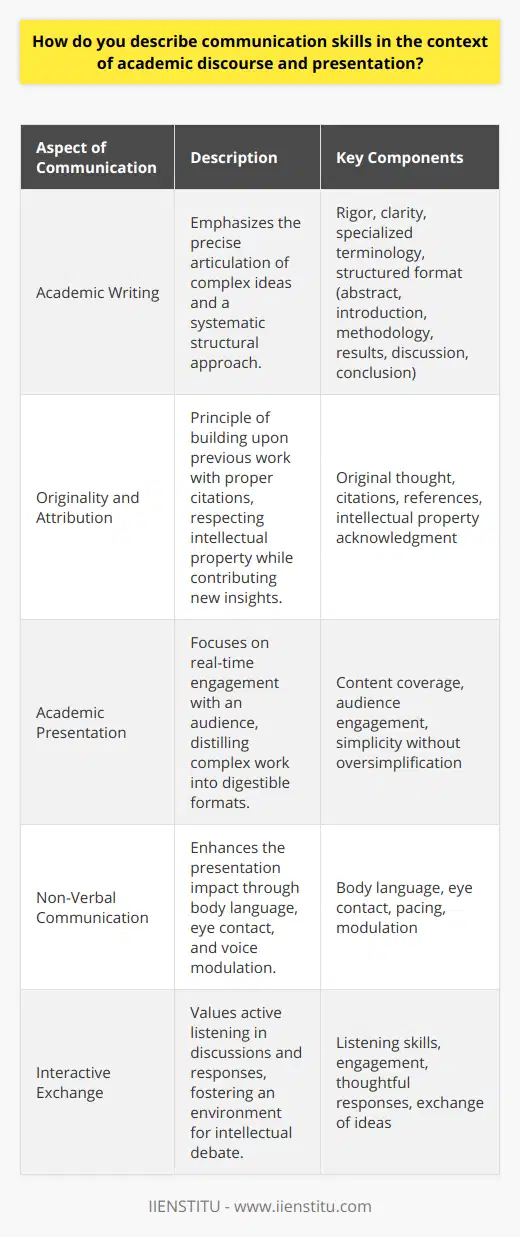
In what ways can feedback mechanisms be employed to assess and enhance communication skills within academic settings?
Assessing Communication Skills
Feedback mechanisms act as critical tools in measuring and improving communication skills within educational frameworks. Individual presentations, group projects, and class participation provide opportunities for these assessments. These activities facilitate direct scrutiny of student communication abilities.
Employment of Peer Feedback
Peer feedback is a particularly valuable approach. It allows learners to evaluate one another's skills objectively. This exchange of insights promotes mutual growth and understanding. Learners can identify their communication strengths and weaknesses through their peers' perspectives.
Improvement Through Tutor Feedback
Tutor feedback plays an essential role in enhancing learners’ communication skills. Tutors can offer professional and practical suggestions. They can help students make adjustments in tone, language, gesture control, and timing during their presentations.
Use of Self-assessment
Self-assessment techniques should not be overlooked. This method encourages students to reflect on their communication strategies. It makes them conscious of their performance and guides them towards self-improvement.
Feedback from Digital Media
In our digital age, various apps and online platforms offer instant feedback. These tools can help students identify gaps in their communication skills. They can then refine their abilities through practice on these platforms.
Adoption of Situated Feedback
Situated feedback, provided in real-time during communication activities, is another effective tool. Immediate advice offered right after presentations or discussions, helps in correction and skill enhancement.
The Bottom Line
In essence, different feedback mechanisms contribute to assessing and strengthening communication skills in academic settings. By embracing these approaches, educational establishments can guarantee the development of articulate, confident, and effective communicators.


